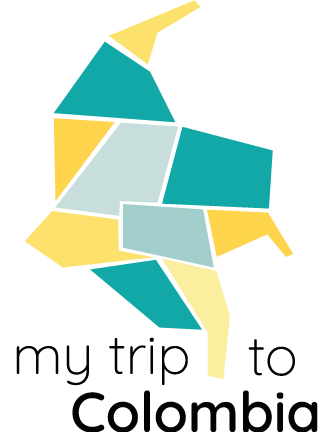In this post, we offer you our feedback on a classic tour of the Guajira desert in Colombia, to which we had the good idea of adding a stage that few people add, and which saved our “bad” experience.
The program was a classic 4-day tour to Cabo de la Vela and Punta Gallinas, to which we added Nazareth and the Macuira National Natural Park, at the westernmost tip of the Guajira peninsula.
Here’s our account of a desert discovery between light and shadow.
Disclaimer: we apologize in advance for any grammatical or syntactic errors, as our native language is not English (we're a Colombian-French couple), so we hope you'll forgive us and still enjoy the information we share with you! Please note that all the information on our blog is based on our own experience, and is checked and updated regularly.
Contents

PSYCHOLOGICAL PREPARATION FOR THE GUAJIRA DESERT in Colombia
To avoid any surprises, we feel it’s important to have some information before setting off into the desert. Here are a few things to expect:
- Seeing a lot of plastic pollution around Rancherias and villages
- Children blocking the road to beg
- Seeing poverty
- Having a problem with the 4×4 (breakdown, puncture, etc.)
Reading advice
Exclusive 5% Off Discount For you
Best Travel insurance for Colombia
Our partner offers the best rates and a 5% discount for our blog readers! (regardless of travel dates)
Our Guajira desert tour in detail
Cabo de la Vela, La Macuira, Punta GALLINAS
It’s important to remember that these are desert tours, and that there are no roads, so everything is done by 4×4. All classic desert tours are very short and intense, with a lot of time spent in the 4×4.
For our part, we had chosen to do a tour that few people choose and that few agencies manage to sell, and yet… it was this choice that saved our experience. We took a 4-day excursion to the Macuira National Park.
Details of our 4-day excursion to the Guajira Desert in Colombia
Day 1 – Riohacha to Cabo de la Vela including
- Stopover in Uribia
- Stop at the Manaure saltworks
- Lunch at Cabo de la Vela
- Climb to Pilon de Azucar
- Sunset at El Cabo de la Vela lighthouse
- Meal and overnight at Cabo de la Vela
Day 2 – Cabo de la Vela to Nazareth (La Macuira) including
- Late lunch in Nazareth
- Meal and overnight in Nazareth
Because the distance between Cabo and Nazareth is so great, we simply drove all day. We arrived in Nazareth mid-afternoon.
Day 3 – Nazareth to Punta Gallinas including
- Visit to the Macuira National Nature Park
- Lunch in Nazareth
- Departure for Punta Gallinas
- Stop at the Taroa dunes of Punta Gallinas
- Stop at Punta Gallinas lighthouse
- Meals and overnight in Punta Gallinas
Day 4 – Punta Gallinas to Riohacha including
- Boat trip on Bahia Hondita
- Flamingo watching at La Boquita.
- Departure for Riohacha
- Lunch in Uribia
- End of tour in Riohacha
Guajira desert tour conditions
Services included
- 4×4 transportation
- Accommodation (hammock or bed)
- Meals
Drivers
Be aware that most of the big local agencies in Riohacha are there to make a profit, and the quality of service becomes uncertain. You need to be lucky… Drivers are hired by the day and are only there to take you from point A to point B, and are not paid to act as guides.
The risk: getting the wrong driver. This is what happened to us, we had the worst driver ever: unpleasant, who treated children badly at toll booths, who denigrated Wayuu culture, and who made up answers to our questions… We also heard of drivers who drank while driving..
Really, having a good driver changes the whole experience!
Number of passengers
Please note that 4×4s can accommodate up to 8 people (2 front seats and 2 benches with 3 seats in the back). We’ve seen tours with full 4x4s and met other travelers on the road who complained about the comfort.
Choose the best local agency
As you’ll have gathered from our post, it’s essential to go into the desert with a serious local agency. After a mixed experience, we decided to look for an agency offering a different kind of tourism.
Paola’s agency is one of the few in Riohacha to develop responsible tourism in the Guajira desert.
Even if the tour basics are the same as the other agencies (Manaure, Cabo de la vela, Punta Gallinas, Macuira), the difference is in the details:
- Safety and reliability (mandatory breathalyzer test for all drivers and 4×4 inspection before each departure)
- More interaction with your Wayuu driver (they are not guides, but they are trained to answer your questions and interact with you)
- Maximum 5 people in 4x4s
- Visit to a Wayuu weaving workshop
- Share with locals around the sacred fire
- Share with the children of Nazareth (if you go to La Macuira)
- Turtle liberation (program to protect endangered Careta turtles)
- Swimming in luminescent plankton
- Community contribution (all services are provided by the community)
- Offers the Macuira Natural Park (and many other destinations in the department)
If you add to this the fact that Paola has been setting up social-interest projects throughout the department for many years, there’s nothing more to think about. Do you think her prices are a little more expensive than elsewhere? Now you know why, and more importantly, you know where your money is going.
From Riohacha to Cabo de la Vela
Discovering the Wayuu territory of Guajira
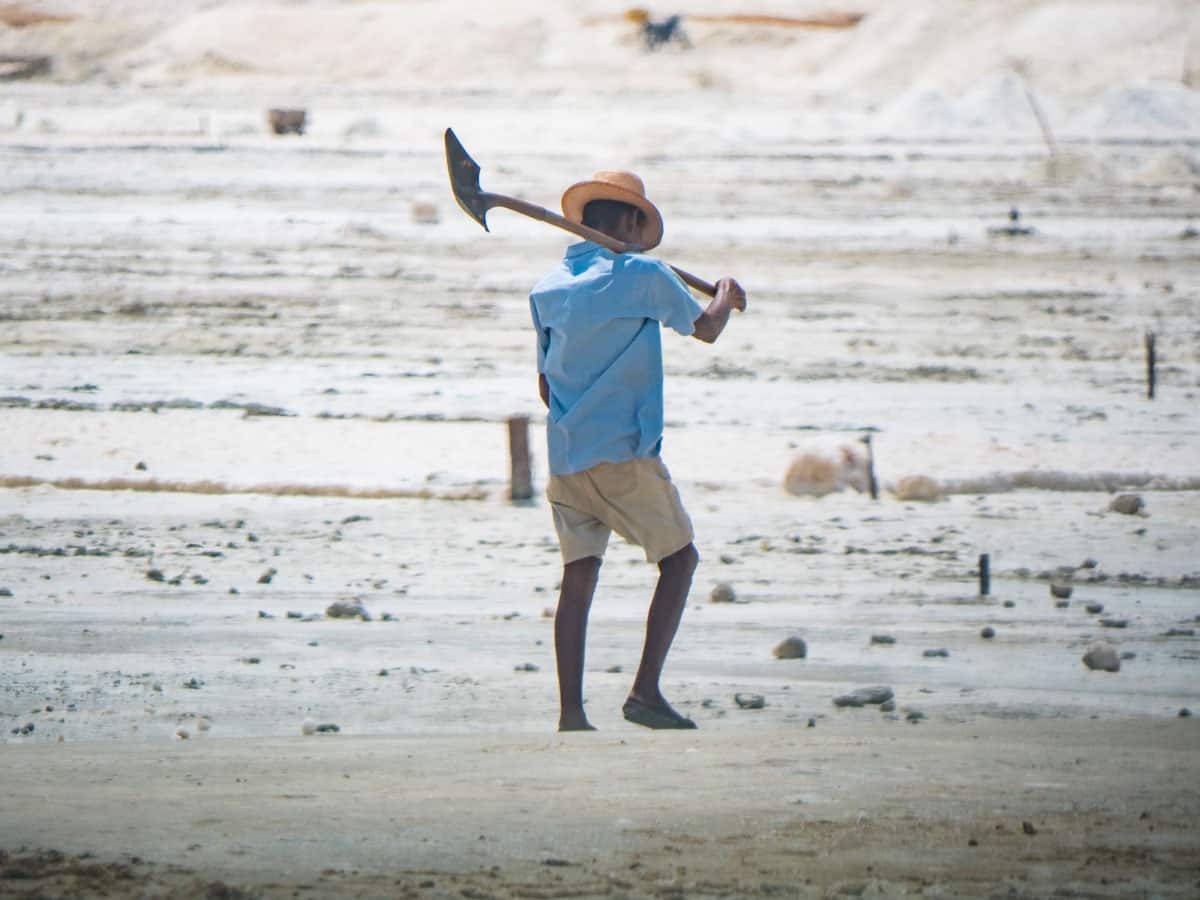
From Riohacha to Cabo de la Vela, it takes approximately 3 to 4 hours by road. We’ll take 5 hours, as we’ll be making several stops to repair the 4×4, including a relatively long one in Uribia. That’s life in the desert!
Stopover in Uribia, Wayuu capital of the Guajira desert
Our driver drops us off in the main square to take his 4×4 to a garage for repairs. We’ll have time to grab a bite to eat at a local bakery, chat to some of the Wayuu mochila sellers and, of course, snap up our favorite bags!
WAYUU MOCHILA
Making a mochila is a remarkable and time-consuming task for Wayuus women. When you consider that this craft is one of the main means of subsistence for families, we invite you to buy a mochila to support them, and to pay the asking price out of respect for the craftswomen.
Stop at the Manaure salt flats
We continue on our way to the Manaure salt flats (all tours pass through here). We’re about to experience our first real awakening.
In fact, we realize that our driver has no intention of explaining where we are, is incapable of answering our questions, and only encourages us to take photos.
Of course we like taking photos, and we’re going to have the chance to take some nice ones here. But what if there’s nothing behind the picture? No story? What’s the point?
We know it’s evolving little by little, and today this stop in the salinas could be very interesting. In any case, it’s very beautiful!
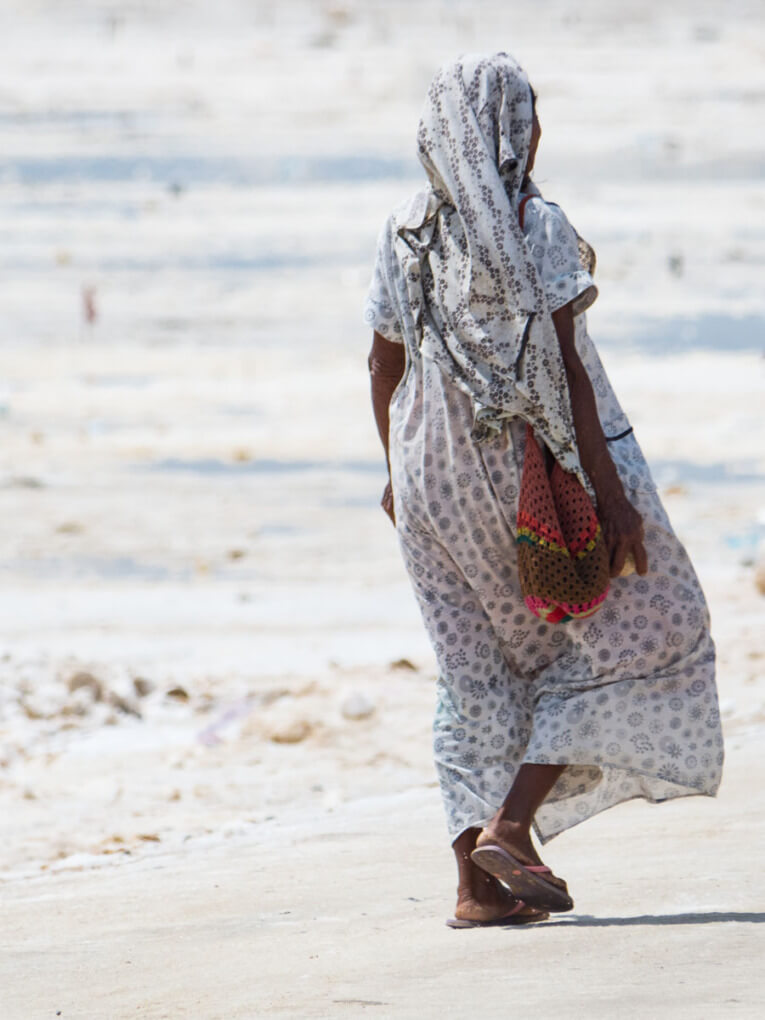
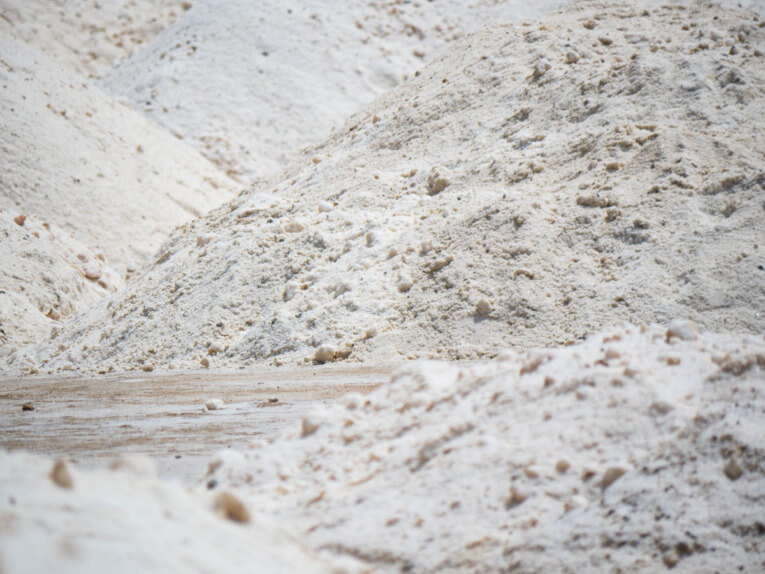
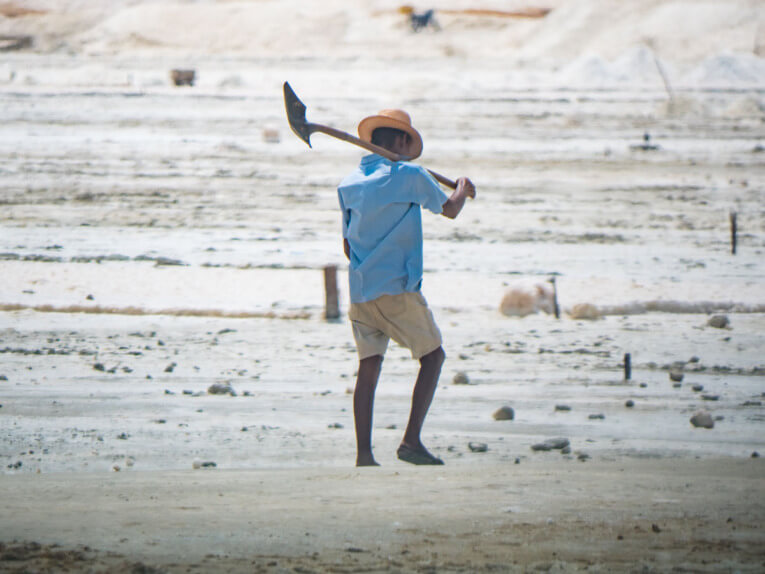
Arrival at Cabo de la Vela
We finally arrive for lunch at Cabo de la Vela, “Jepira” in the Wayuu language.
Once we’ve left our belongings in our room, we have lunch at the restaurant on the tour. Then the driver takes us on to the next part of the program: Pilon de Azucar, swimming and sunset at the Cabo de la Vela lighthouse.
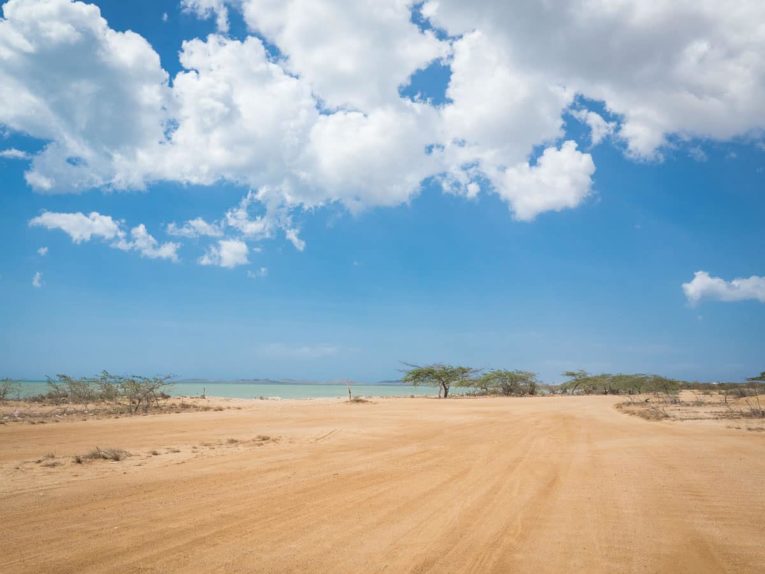
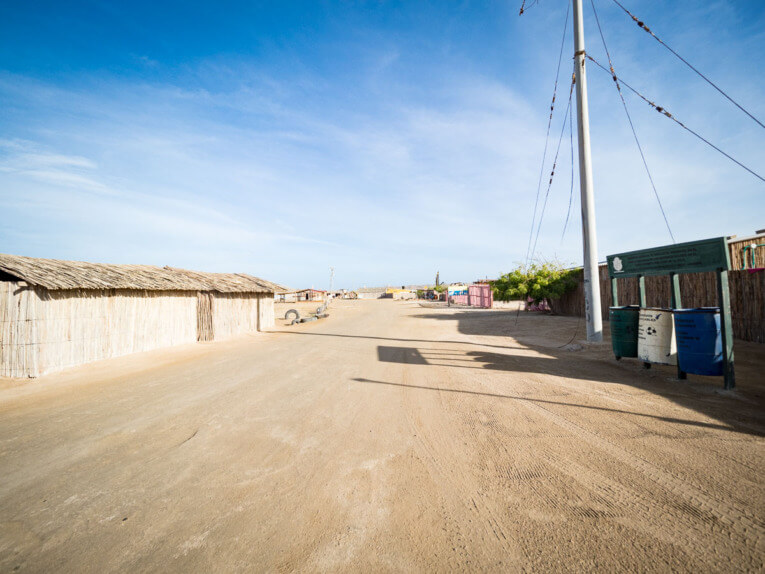
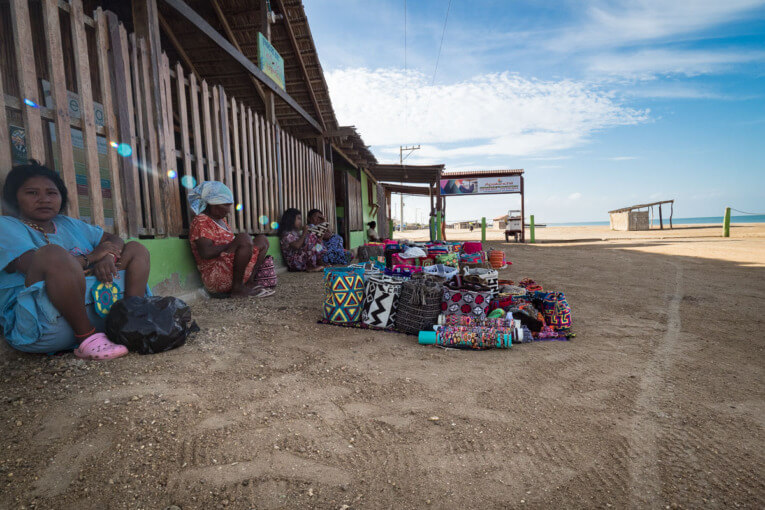
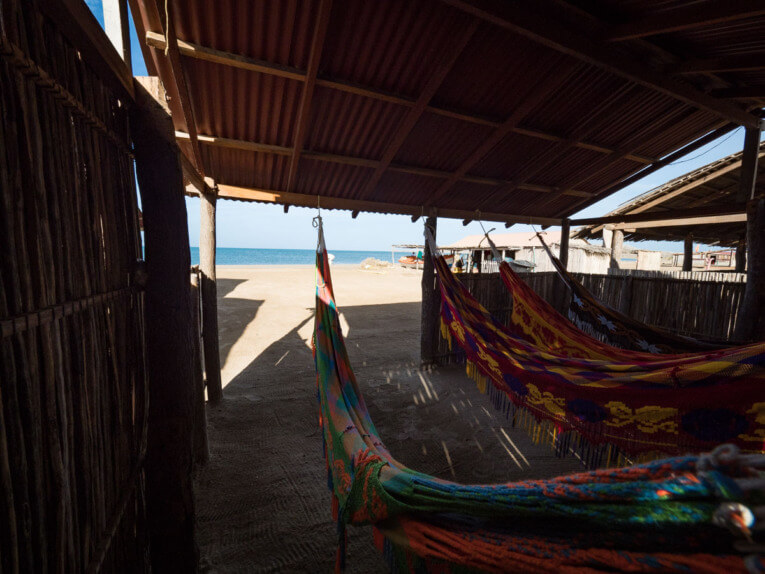
Pestle of Azucar
Once there, we were encouraged to climb to the top of the pilon to take photos. What is the name of this mountain in the Wayuu language? Does it have any significance? Our questions remain unanswered.
At the top of Kaimachi (the Wayuu name for Pilon de Azucar), we admire the view of the Caribbean coast and the striking contrasts between the azure of the sea and the ochre of the land. The landscape is truly sublime!
We’re then given some time to cool off on the beach – a welcome swim. The sea is splendid, warm and clear, and the location spectacular.
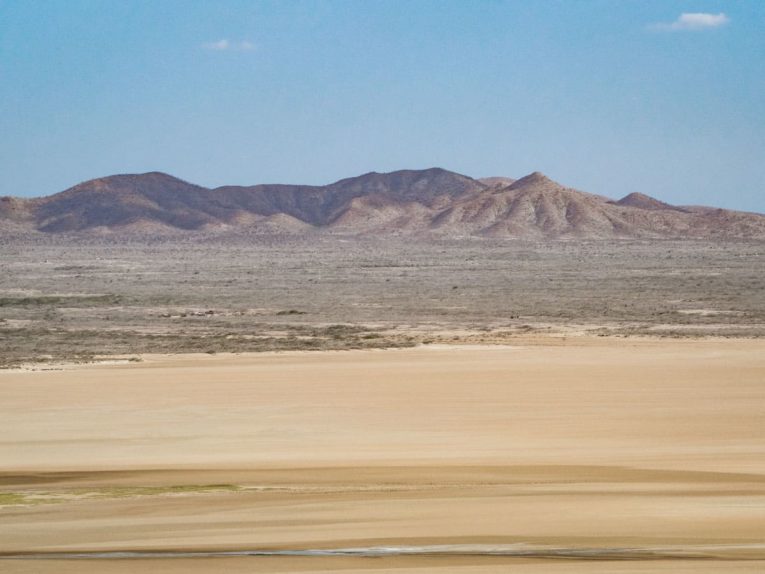

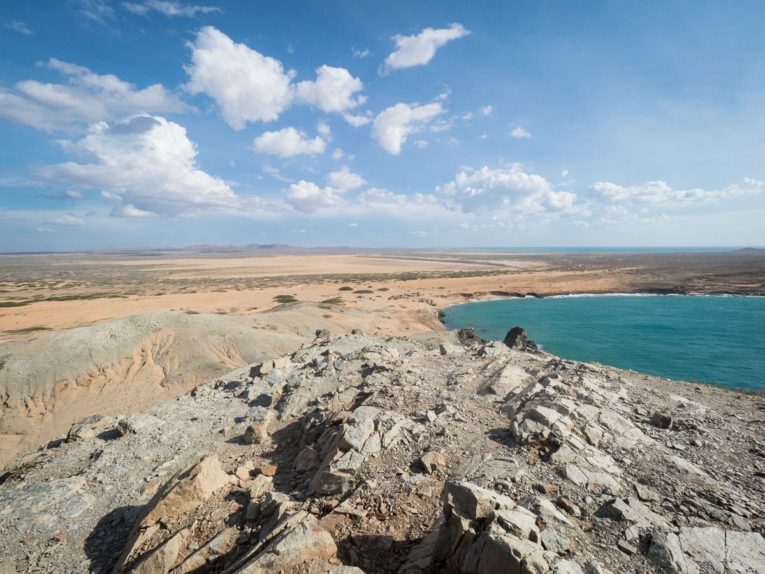

Jepira, sacred territory
We know, from having read a lot about the Wayuu and Guajira in Colombia before leaving, that Cabo de la Vela, Jepira in the Wayuu language, is sacred territory.
Jepira means “where souls rest”, and in Wayuu cosmology, it’s the place where the souls of the deceased are taken before their ascent to the stars.
Cabo de la Vela lighthouse
We set off again for a short drive to the Cabo de la Vela lighthouse, everyone disembarking, and the day ends with a sublime sunset over the Caribbean Sea.
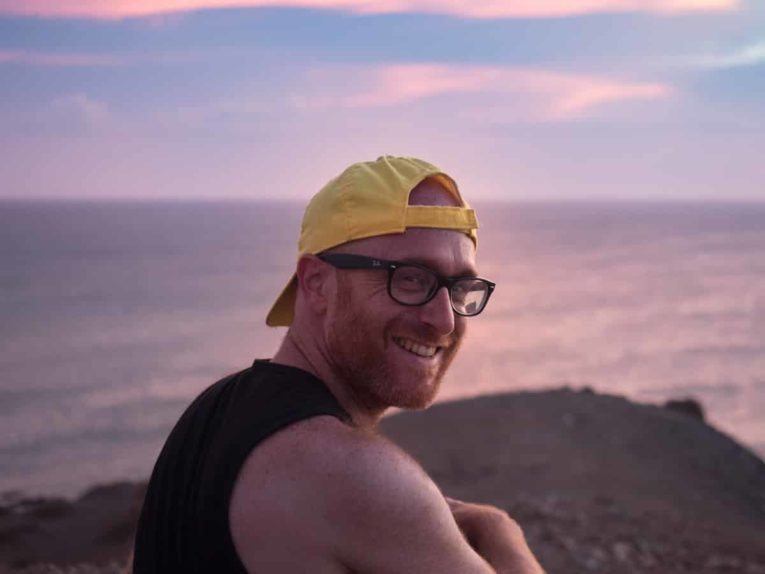
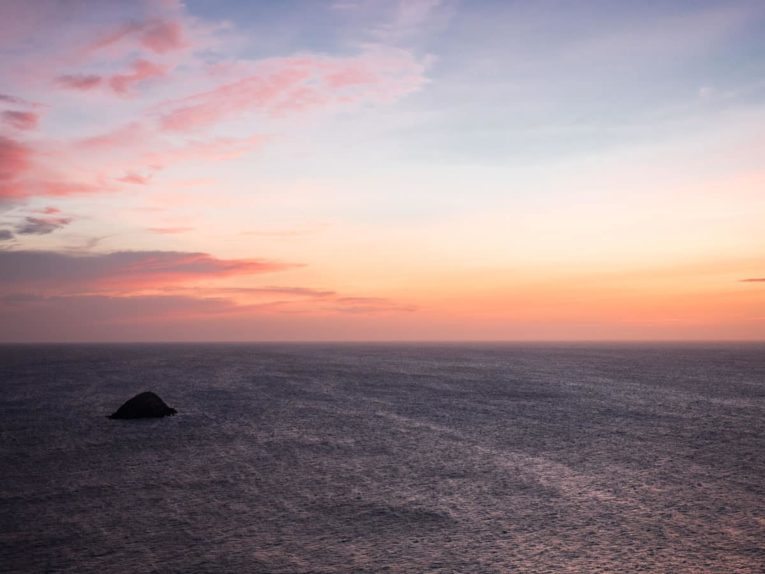

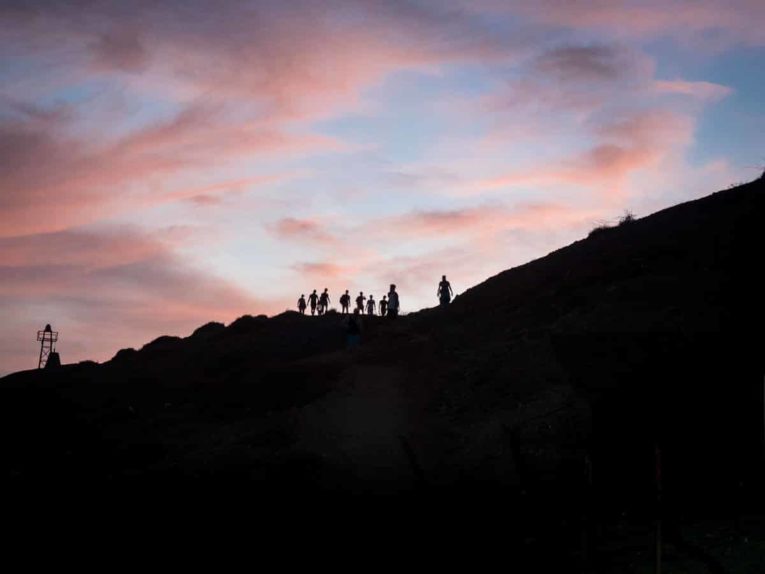
After spending the night in the village of Cabo de la Vela, we set off again early the next day, as a 7-hour drive to Nazareth at the eastern end of the Guajira peninsula awaits us.
We’re telling you right now, it’s worth the effort. Because despite the distance, despite the length of the journey to get there, the visit to Nazareth and the Macuira Natural Park will remain our best memory of the Guajira.
Responsible Local Agency
As you’ll have understood from our post, it’s essential to go into the desert with a serious agency. Paola’s agency is one of the few in Riohacha to have developed responsible tourism in the Guajira desert. You can go with your eyes closed and break the piggy bank to go as far as Macuira!
From Cabo de la Vela to La Macuira
VISIT THE GUAJIRA DESERT in Colombia
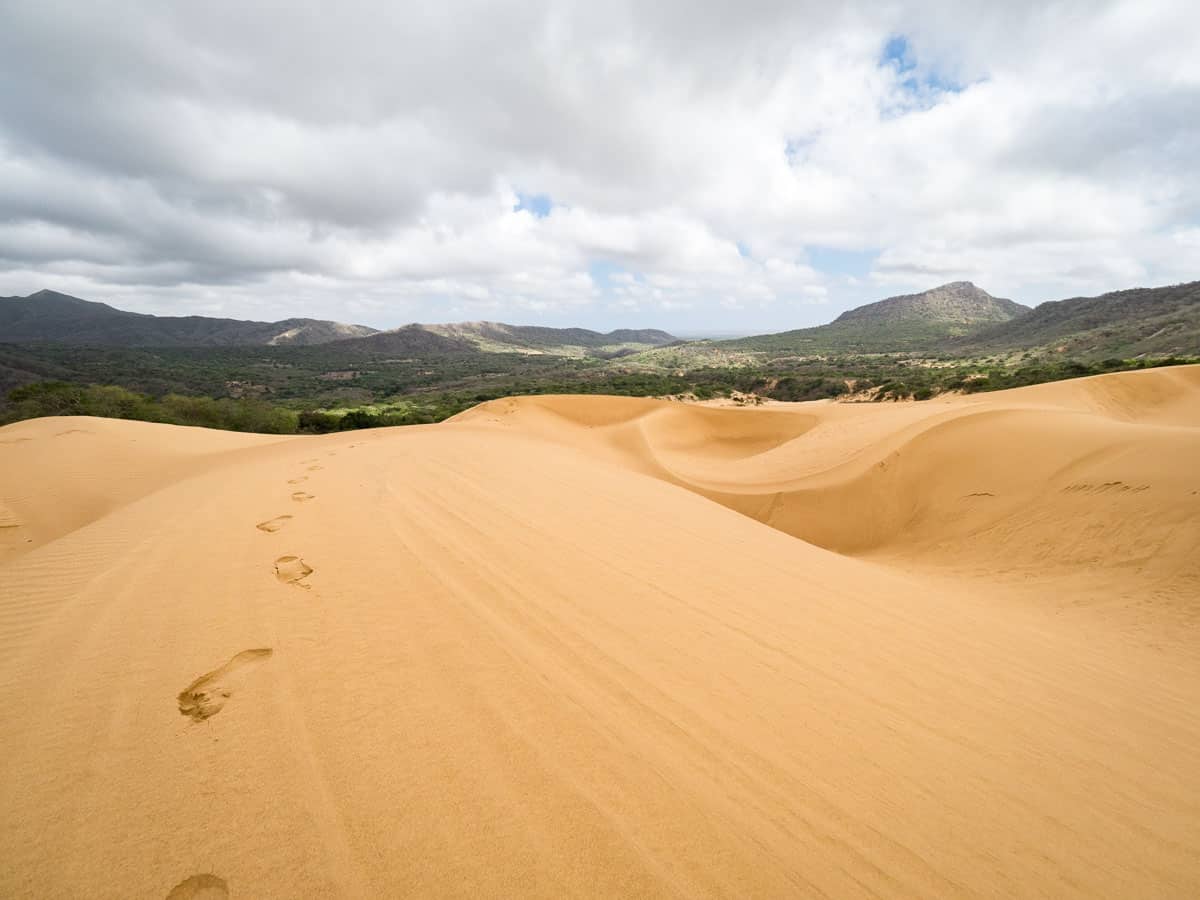
After 7 hours on the road, driving non-stop through impressive desert landscapes that are gradually changing, we reach the village of Nazareth. We’ve finally arrived, at the very tip of the Guajira peninsula.
Nazareth, a Wayuu village on the edge of the desert
Nazareth has the ambiance of an indigenous village, where traditions are perpetuated away from the hustle and bustle of the world.
We literally force our driver to stop us in our mad rush for a beer on the street corner. To settle down. Watch life go by, if only for a few moments. Breathe a little… live.
We finally arrive at our accommodation, a hotel with a swimming pool… we weren’t expecting it, given the water problems in La Guajira! And while it’s true that the Macuira region has a privileged microclimate and greater access to water than the rest of the desert, the presence of a swimming pool was strange.
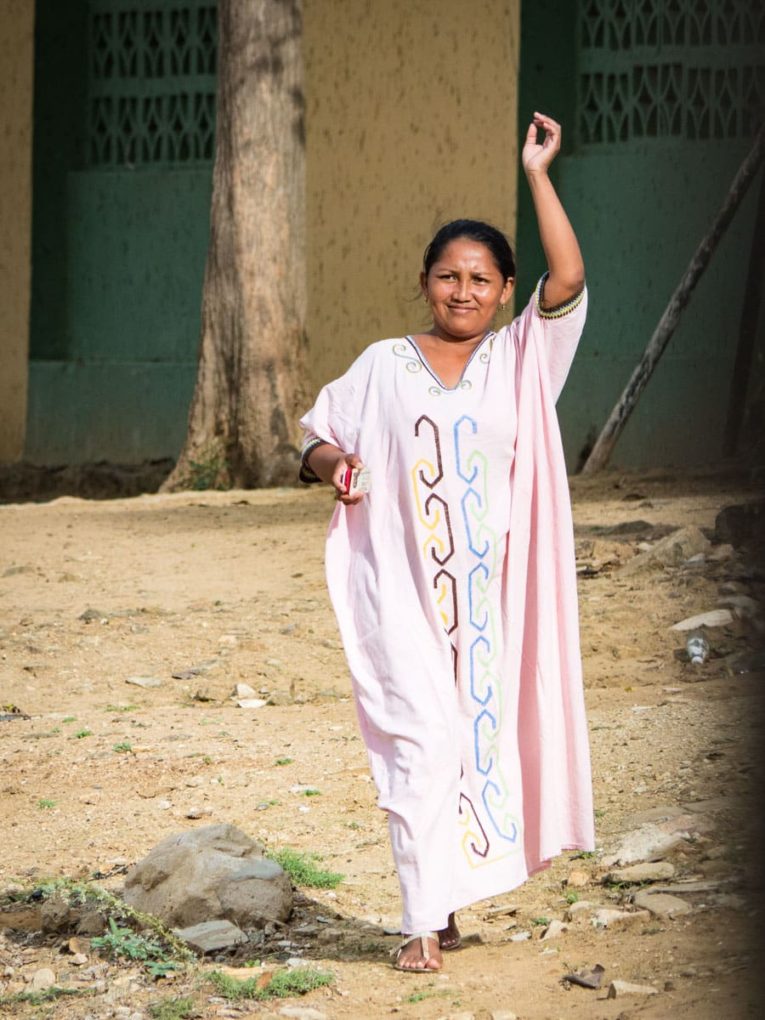


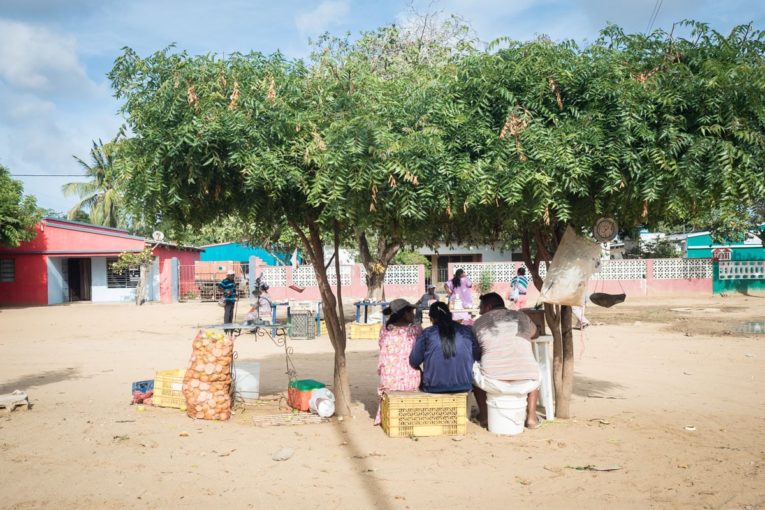
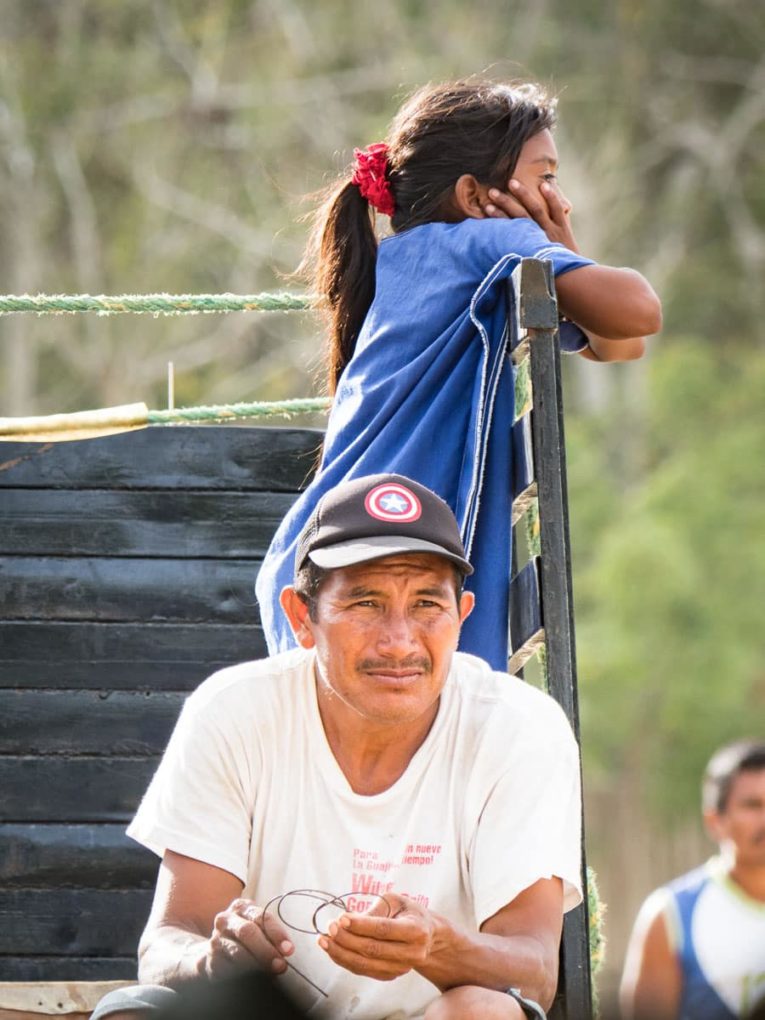
La Macuira National Park
The next morning we visited the Macuira Natural Park. As well as being a nature reserve, the park is also a protected area inhabited by 54 Wayuu families. La Macuira Park acts as an oasis in the middle of the desert. Its ecosystem makes it a fertile territory where crops can be grown for part of the year.
For this hike in the Parc de la Macuira, we are (FINALLY) accompanied by a Wayuu guide, Mayerli, the park’s natural ranger. For the next four hours, we’ll finally be able to talk about Wayuu culture, Colombia’s largest indigenous population!
Mayerli, calm and reassuring, shares her knowledge of the Wayuu people, their traditions and cosmovision, patiently listening to our questions and trying to answer them with simplicity. A real treat!
WOLUNKA
In Wayuu cosmovision, Wolunka is the mother who gave birth to the Wayuu people. Legend has it that Wolunka, the woman with the vagina and teeth, was unable to give birth… to find out more about the legend and the Parc de la Macuira, click below!

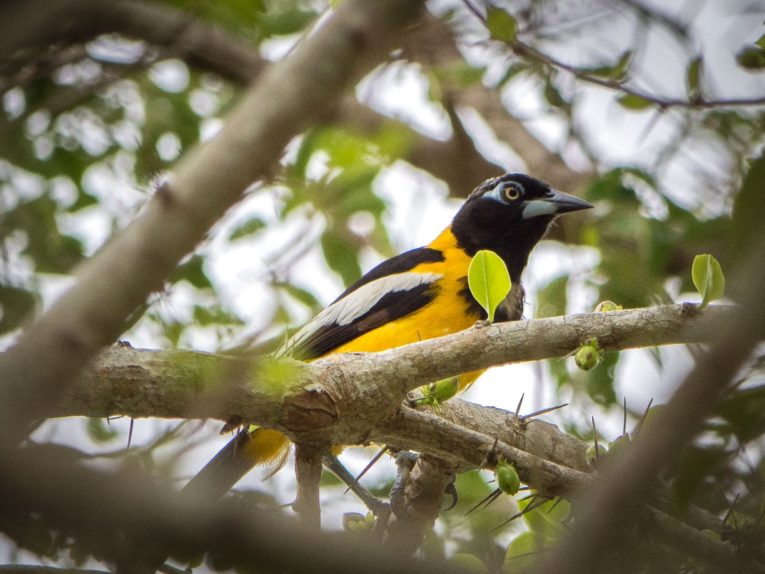
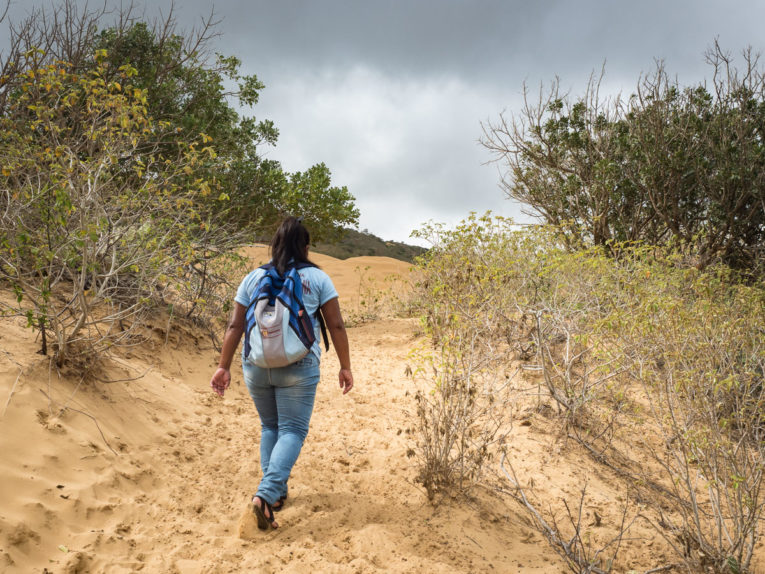
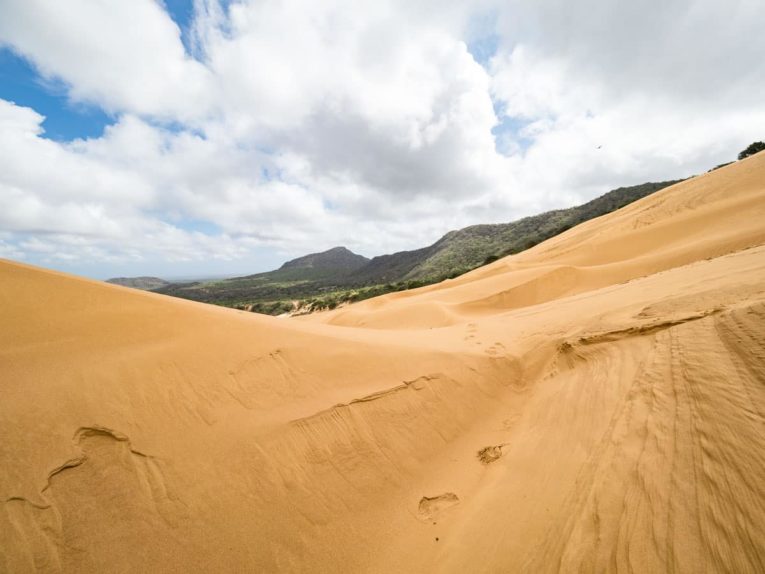
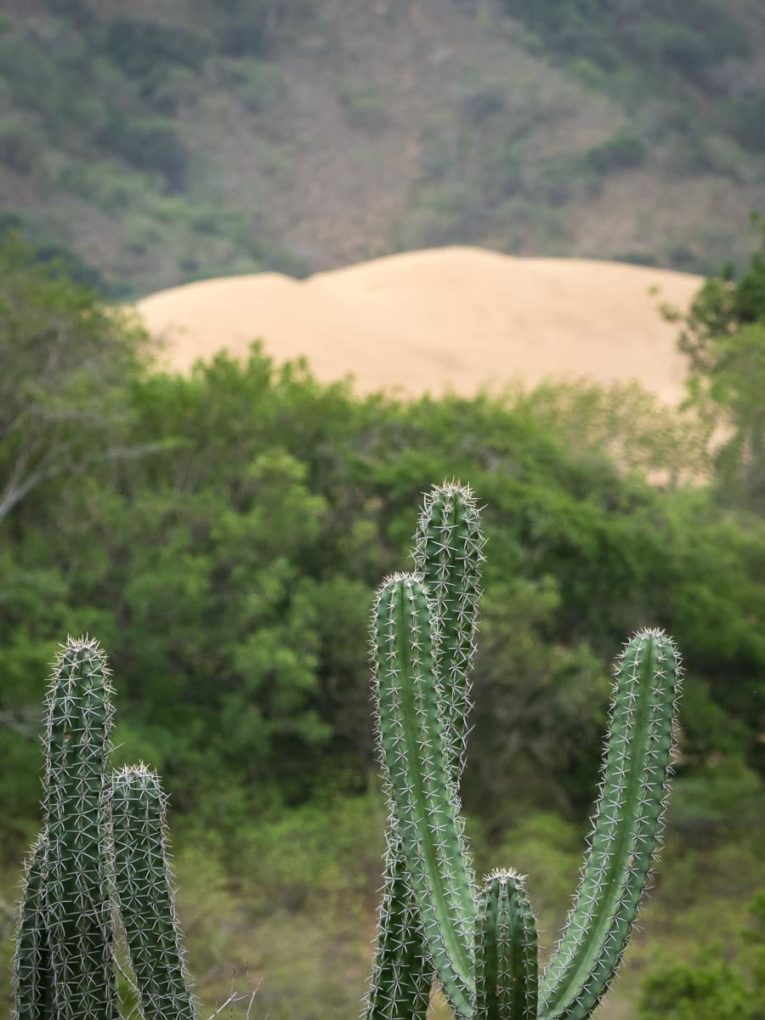
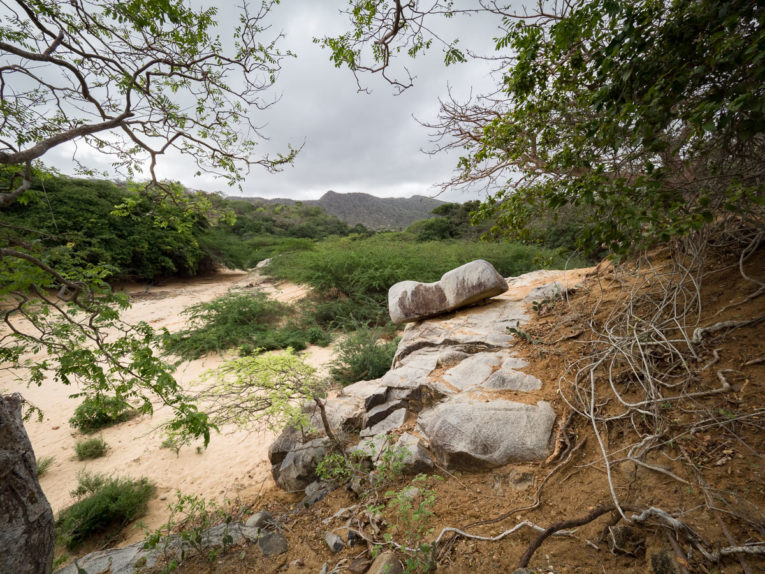

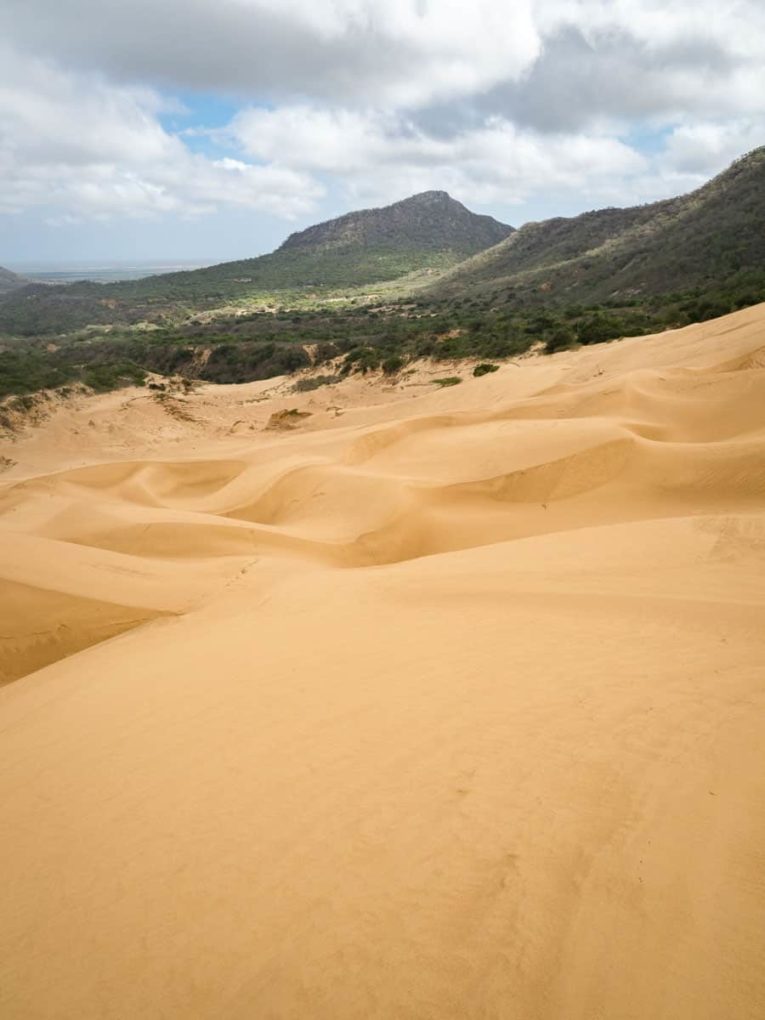
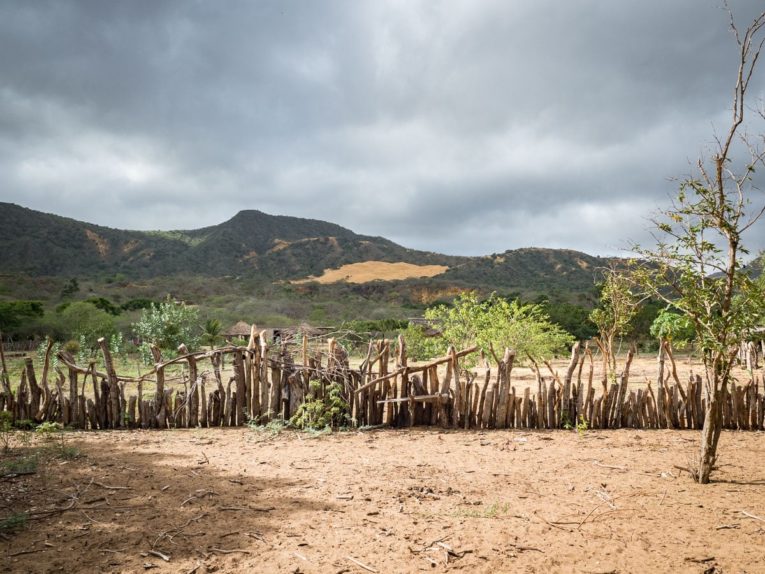
The Aleewolu’u dunes
After a two-hour walk in the Macuira Park, in the midst of a surprising forest filled withan impressive variety of birds , a bright ochre spot suddenly emerges in the middle of the mountain, as if from the hands of a mischievous painter:the Aleewolu’u dunes await us for a grandiose spectacle!
In the Wayuu language, Aleewolu’u means “where friends meet”. Mayerli tells us that it’s in this unique place that they meet to celebrate their birthdays.
We’re really enjoying this moment, admiring the incredible landscape. We’re definitely glad we made the decision to come here. With this meeting with Mayerli, our conversations and these landscapes… everything else takes a back seat.
After our hike in the Macuira Park, we have a quick lunch in the village center of Nazareth and then head back to Punta Gallinas.
Responsible Local Agency
As you’ll have understood from our post, it’s essential to go into the desert with a serious agency. Paola’s agency is one of the few in Riohacha to have developed responsible tourism in the Guajira desert. You can go with your eyes closed and break the piggy bank to go as far as Macuira!
From Nazareth to Punta Gallinas
DISCOVER THE GUAJIRA DESERT
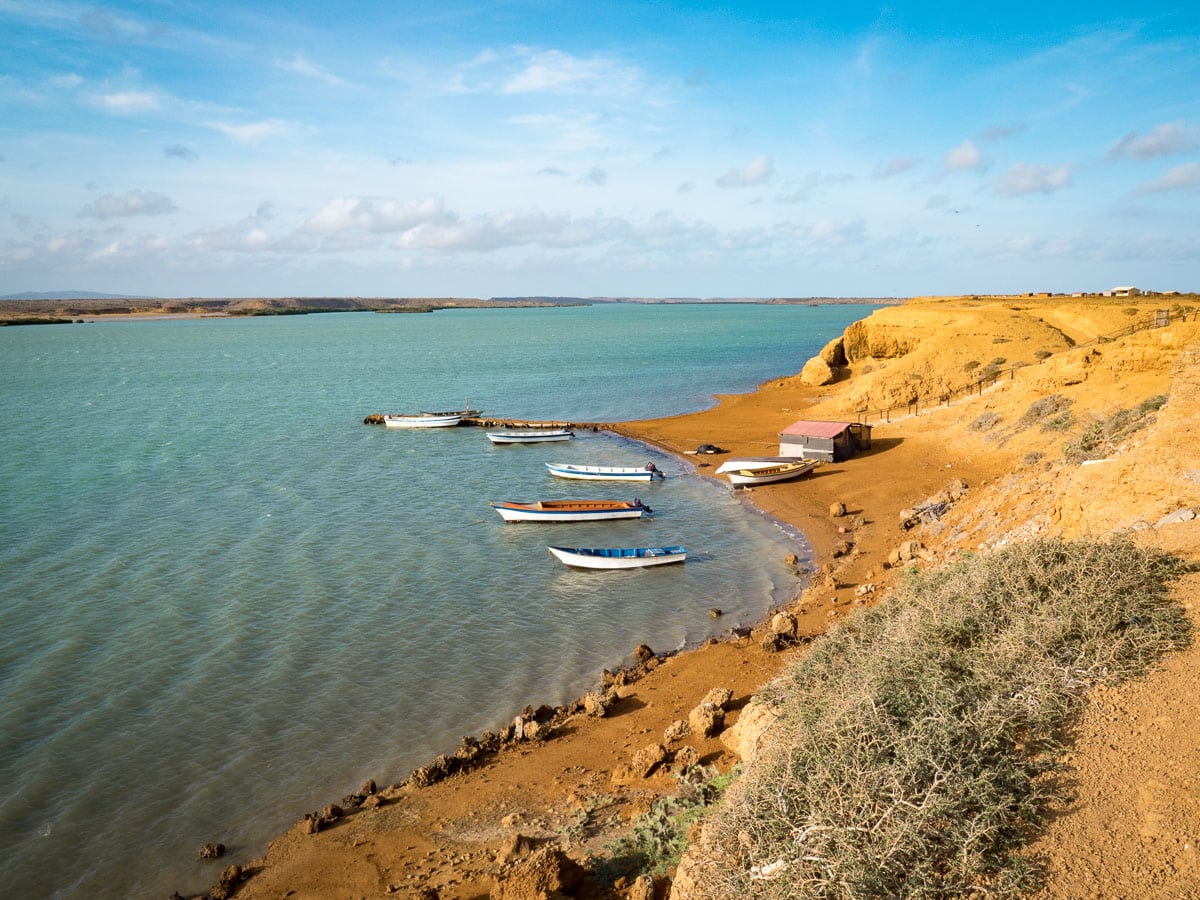
From Nazareth to Punta Gallinas, three hours of packed track await us, through magnificent scenery, on our way to the famous Taroa dunes. The Taroa dunes are one of the best-known points of interest in Colombia’s Guajira region.
The Taroa Dunes
We meet up with the convoys of tourists making the traditional tour of Cabo de la Vela at Punta Gallinas. The 4×4s stop as close as possible to the dunes, and everyone gets out. We learn that until recently, 4x4s drove right up to the top of the dunes, so that tourists didn’t have to walk up..
Once we reached the top (on foot), we admired the spectacle: large, beautiful golden sand dunes plunging down to the sea. We enjoy our second swim of the tour before heading back to the Punta Gallinas lighthouse.
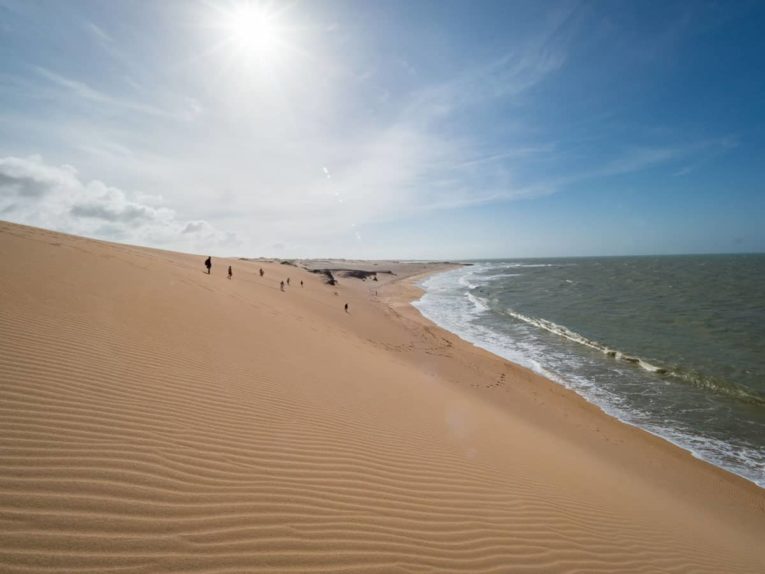


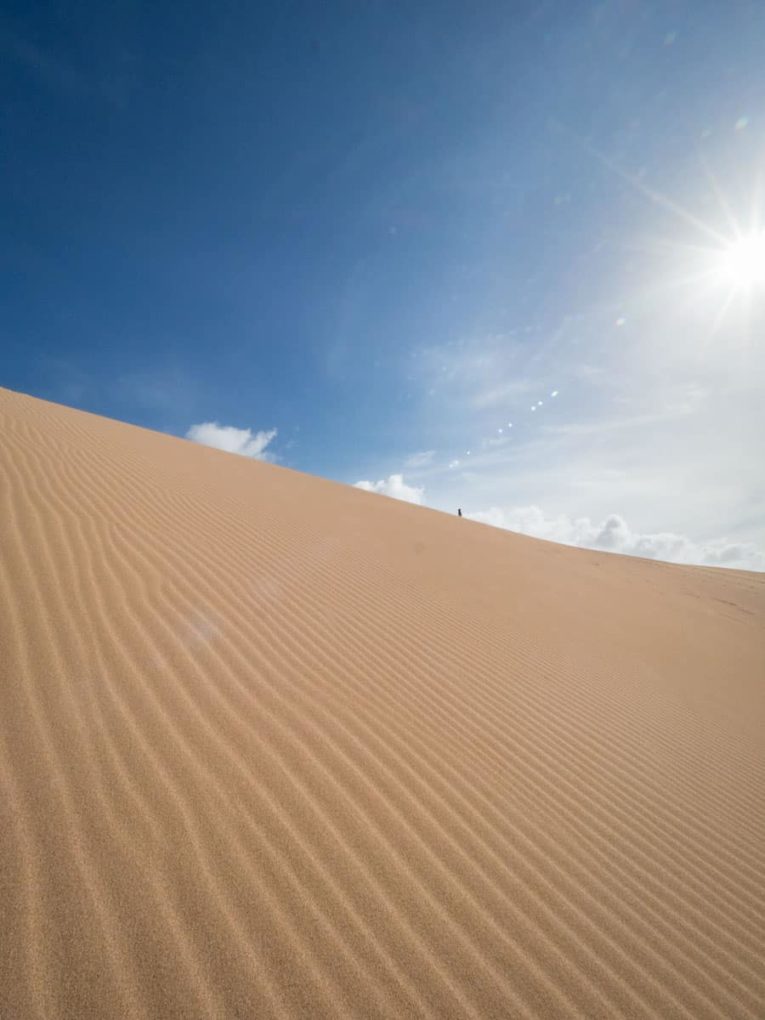

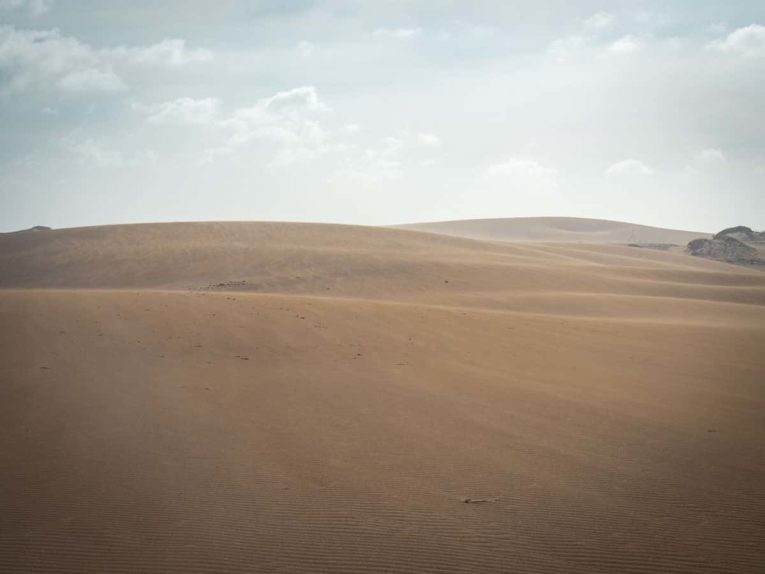
Punta Gallinas lighthouse
The famous northernmost point of the South American continent. In other words, the northernmost point of South America. A lighthouse. Kerns.
A simple photo stop and off you go.
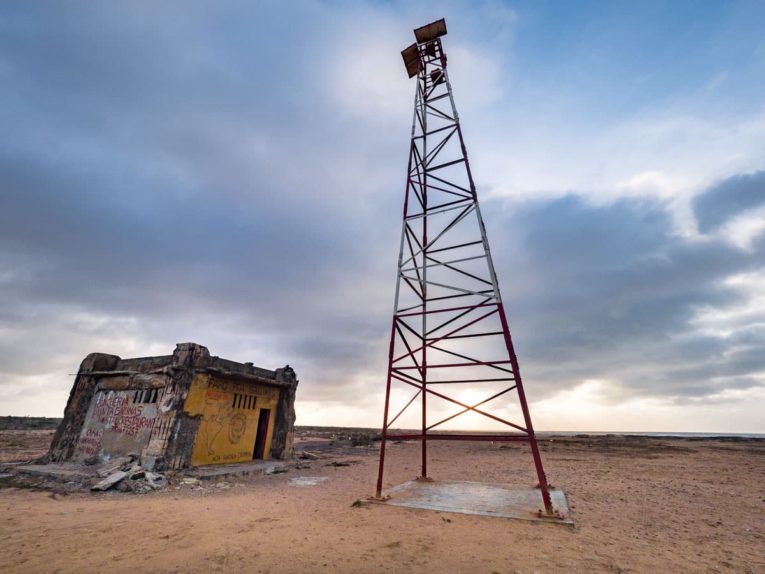
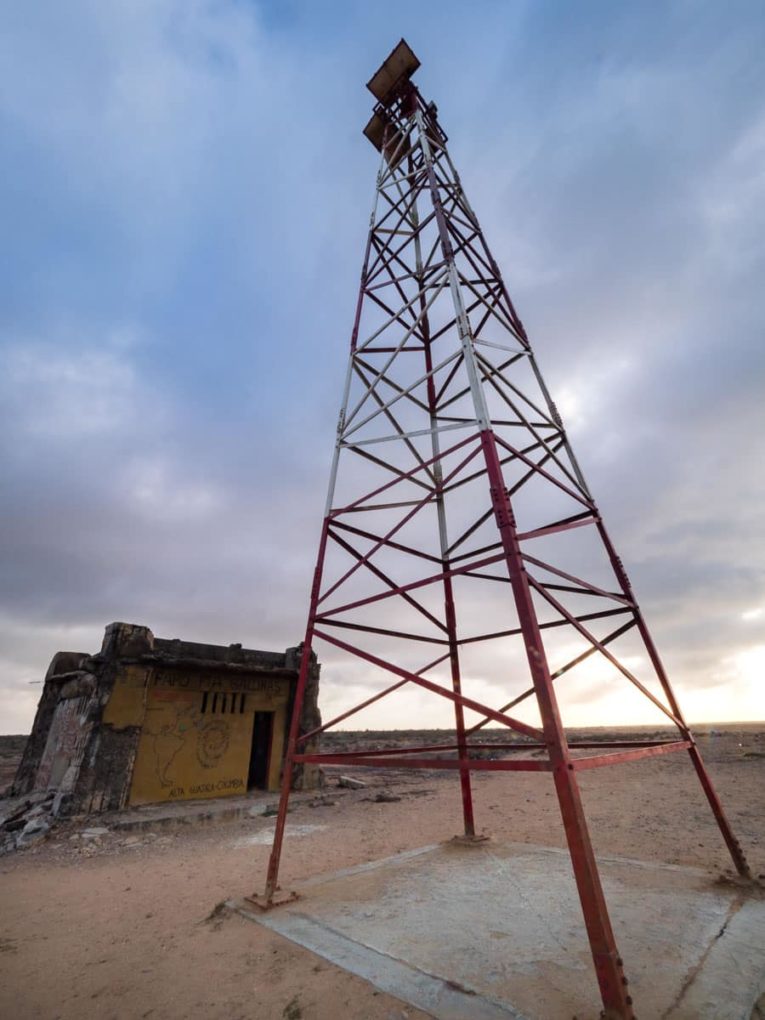
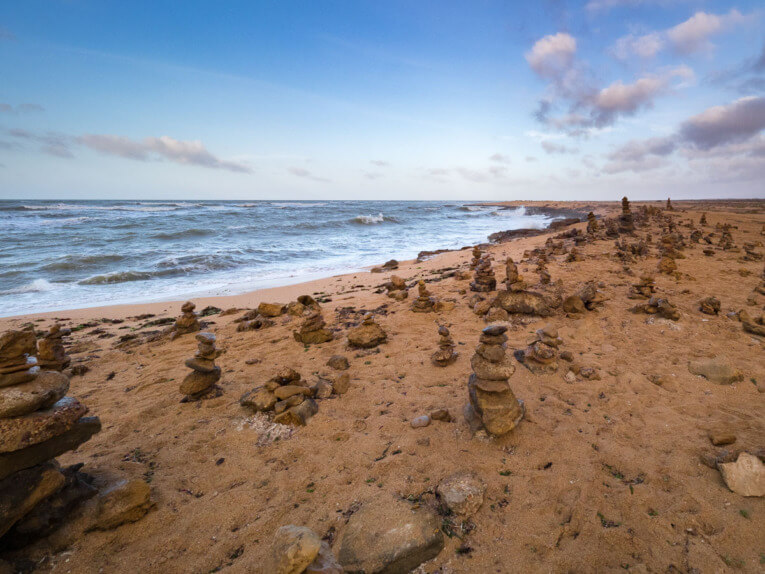
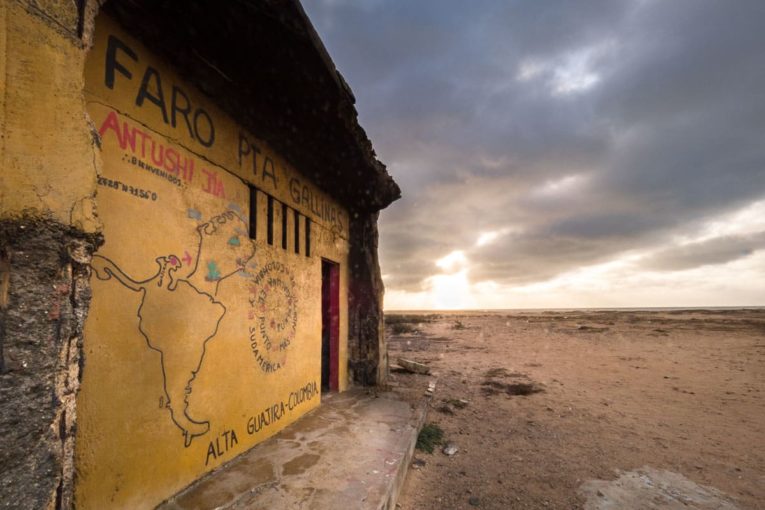
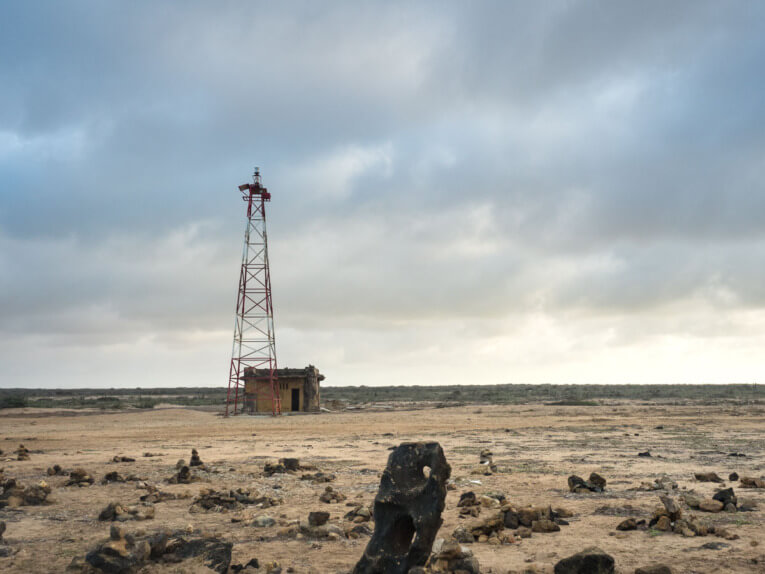
We won’t have time to admire the sunset from Punta Aguja beach, so we’ll head straight to the huge rancheria of the famous Luz Mila for the night.
Rancheria Luz Mila
Luz Mila is a pioneer, the first to welcome tourists to Punta Gallinas “just like home”. The rancheria is located on the edge of the magnificent Bahia Hondita. An extremely photogenic spot.
But don’t expect to meet the Wayuus and learn about life in a rancheria- those days are long gone. Today, the place is huge and seems to be able to accommodate several hundred people at a time.
Of course, it’s also important to understand that, with the increase in tourism and capacity, the activity of this rancheria now provides a financial contribution to many families in the surrounding area (cooking, maintenance, transport, handicrafts, etc.)
The service is very good, and you feel at home.
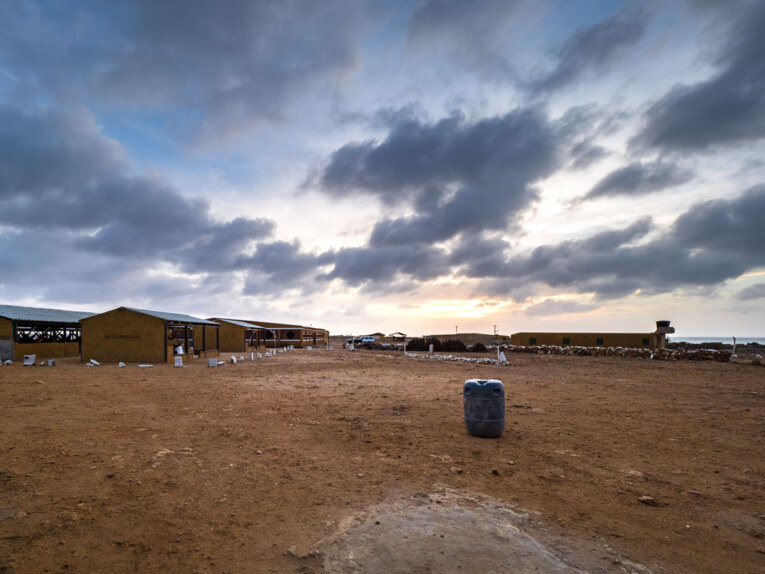
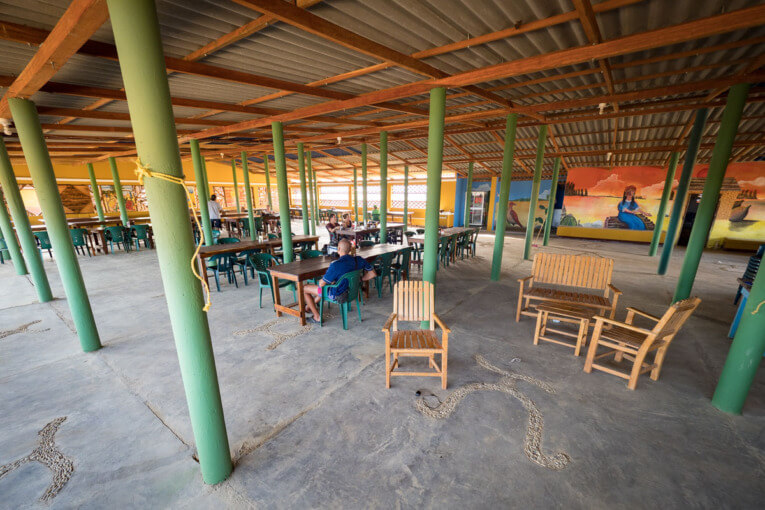
Our stay in the Guajira desert comes to an end. This last night in Punta Gallinas offers us one of the most beautiful skies we’ve seen on our trip.
Awakened at 3 a.m., we leave our room to admire the constellations silently unfolding before us… Later, at around 5 a.m., we manage to get up again to admire the sunrise… magical moments!
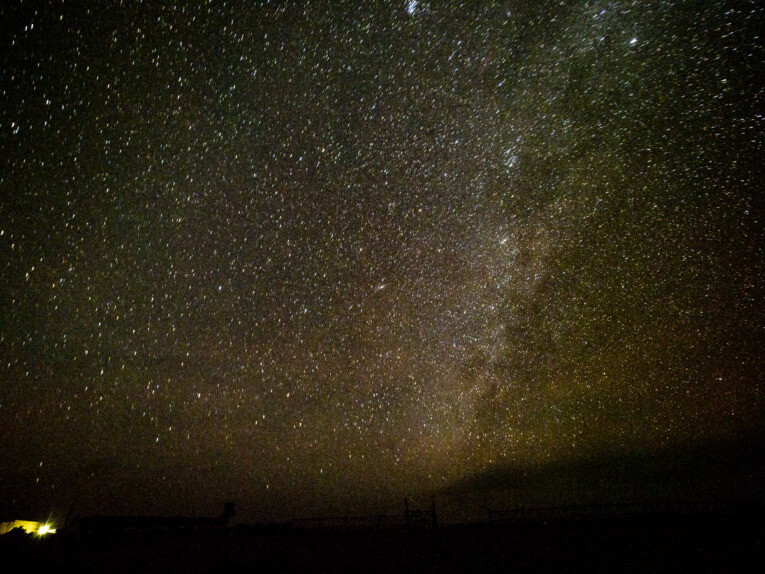
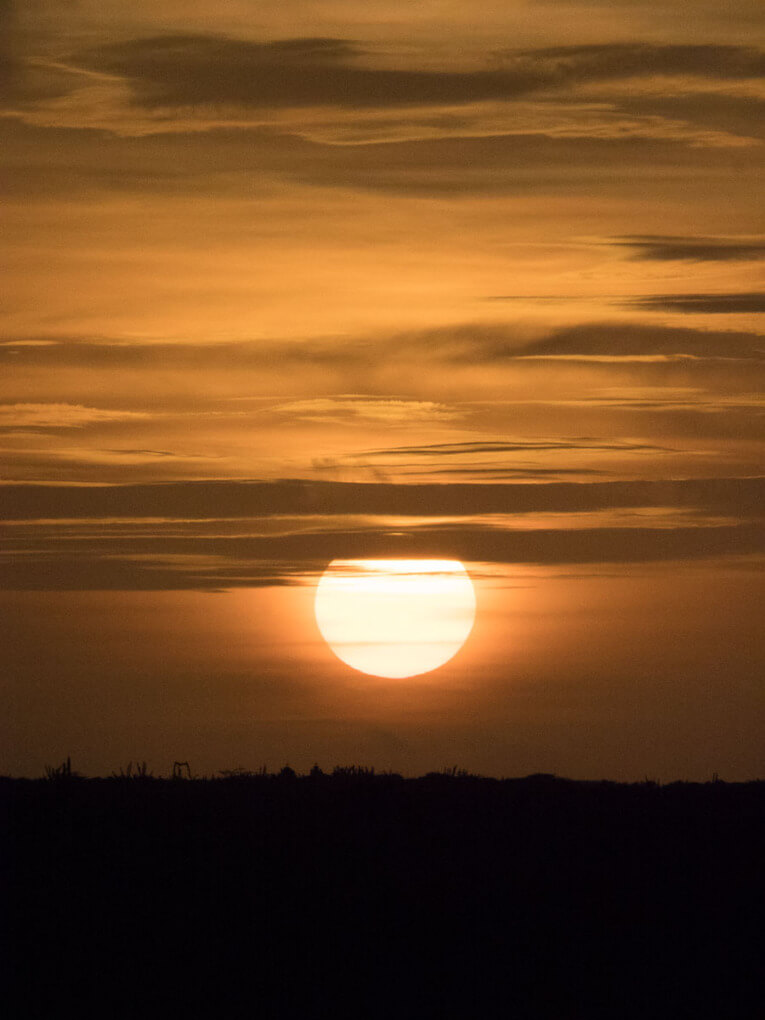
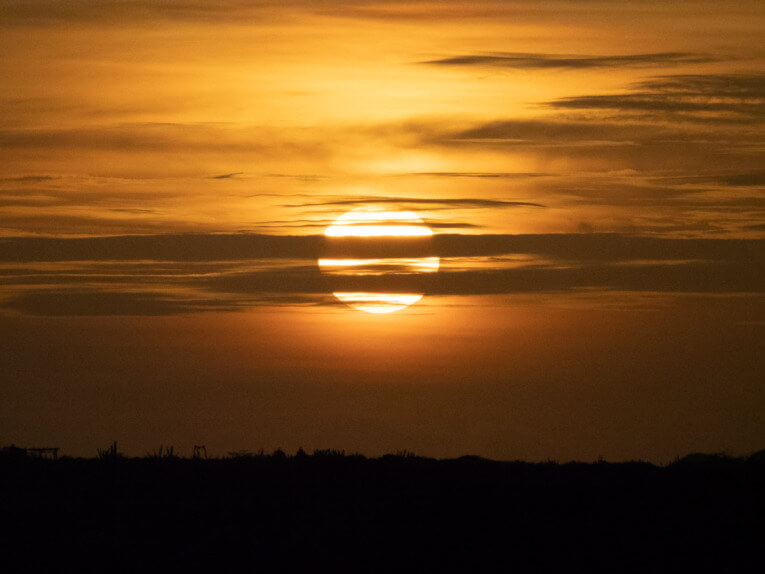
Bahia Hondita
In the daylight, we discover the magical Bahia Hondita.
The color contrasts are breathtaking!
Ochre cliffs, as if sculpted by invisible waves, plunge into a turquoise arm of the sea. In the distance, a strip of mangroves forms a makeshift mangrove swamp. Here, an abandoned boat marks the human presence with a touch of color, as simple as a painting.
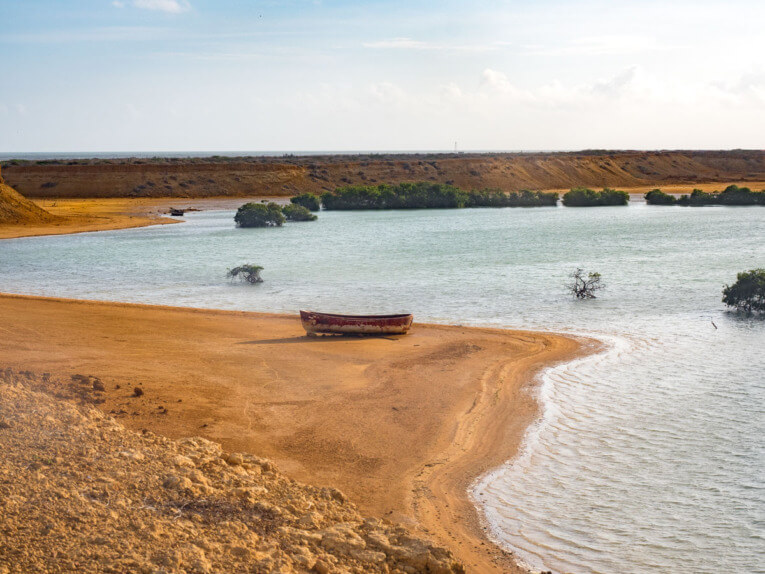
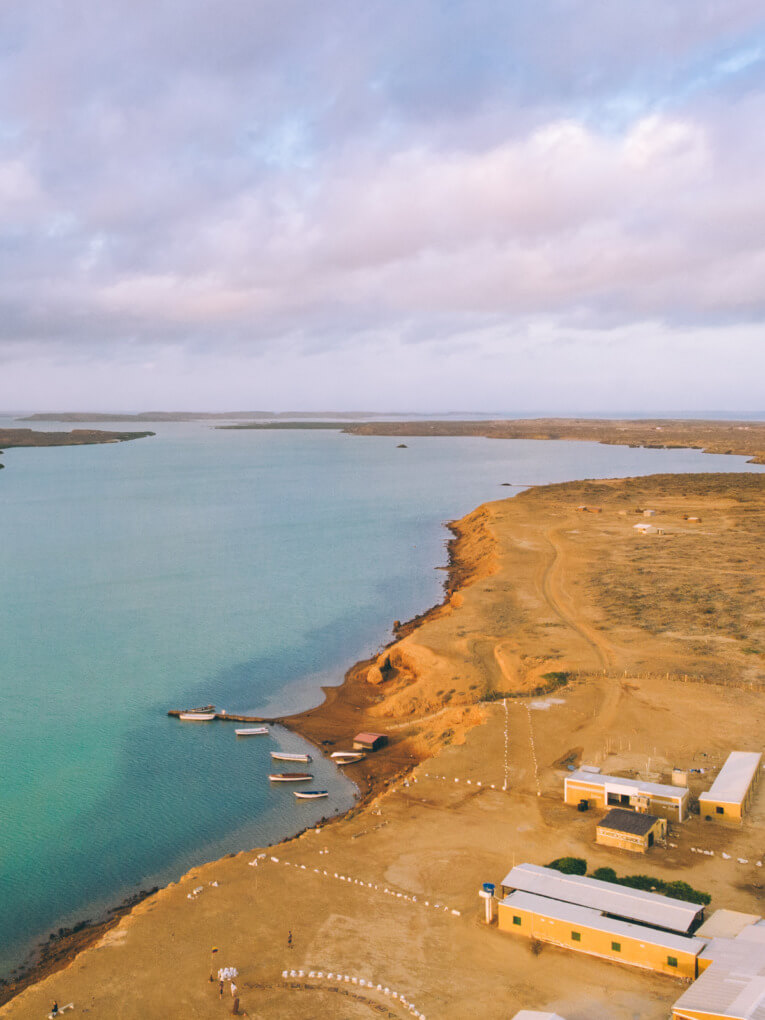
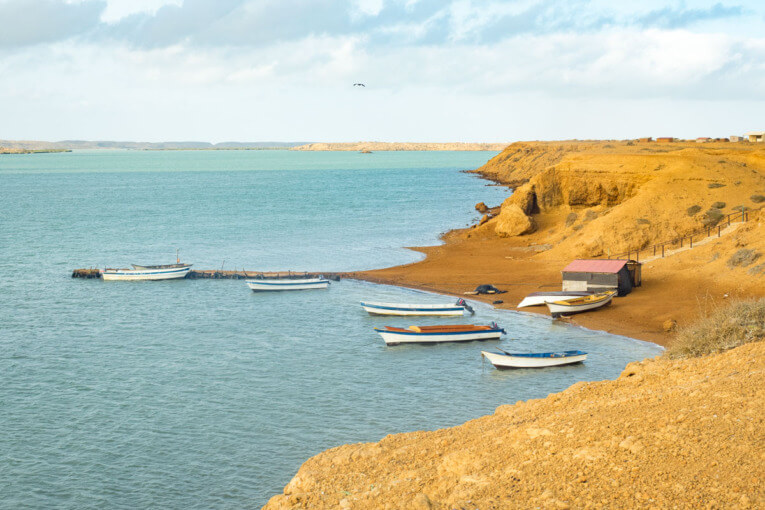
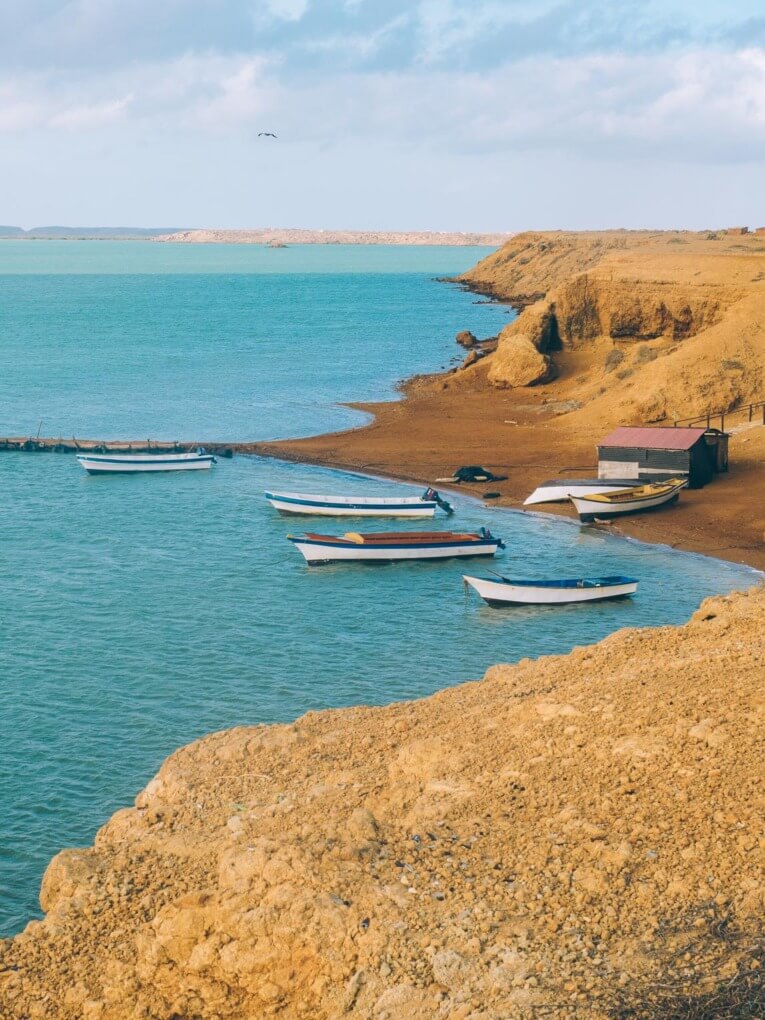
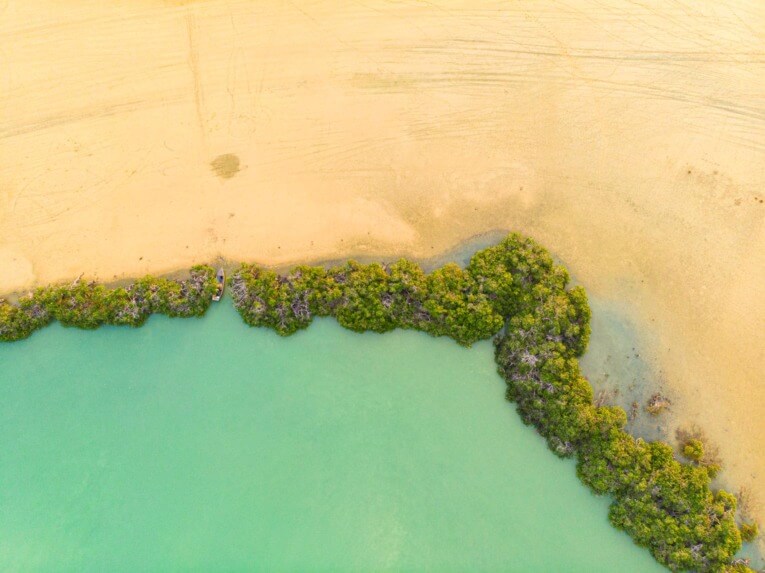
After breakfast, all the tourists at La Rancheria are invited to hop on a lancha and head for La Boquita.
The fresh early-morning air whips across our faces, and this little ride on the green waters of Bahia Hondita is a real pleasure. We arrive on the Boquita peninsula.
Flamingos can be seen in the distance. All the groups disembark, and we’re let loose on these strange, stilted animals. Time for a few shots and it’s time to head back to Riohacha. It was beautiful!
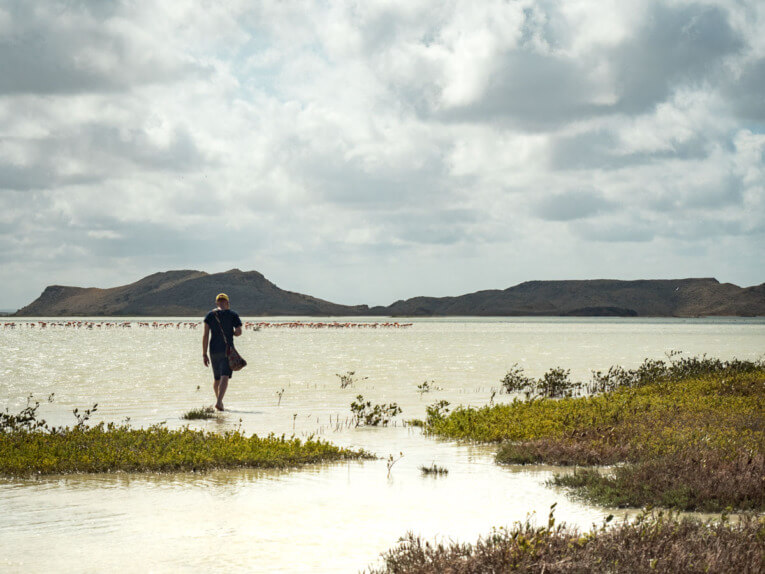
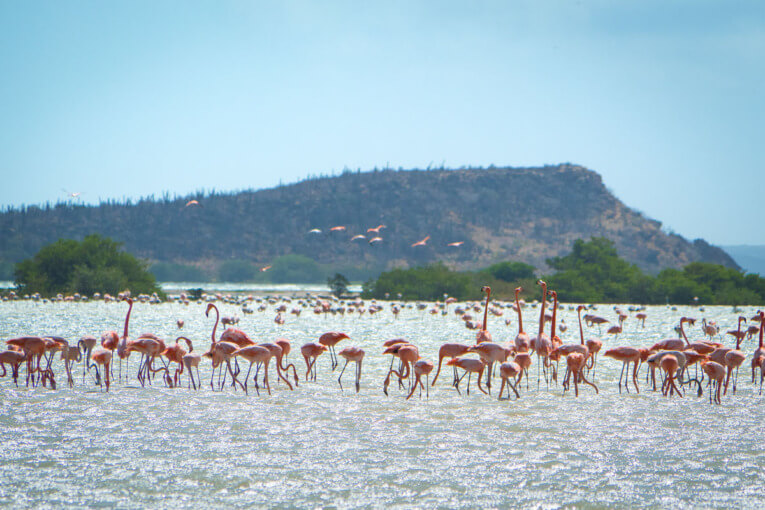
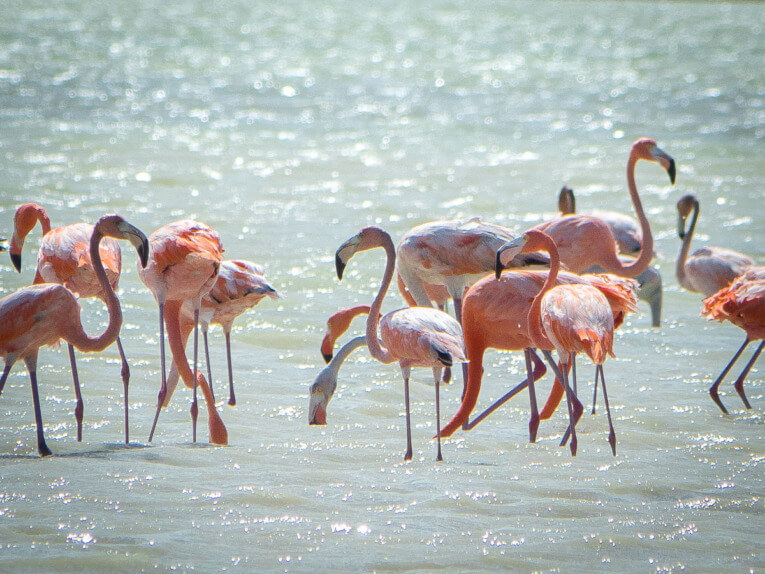
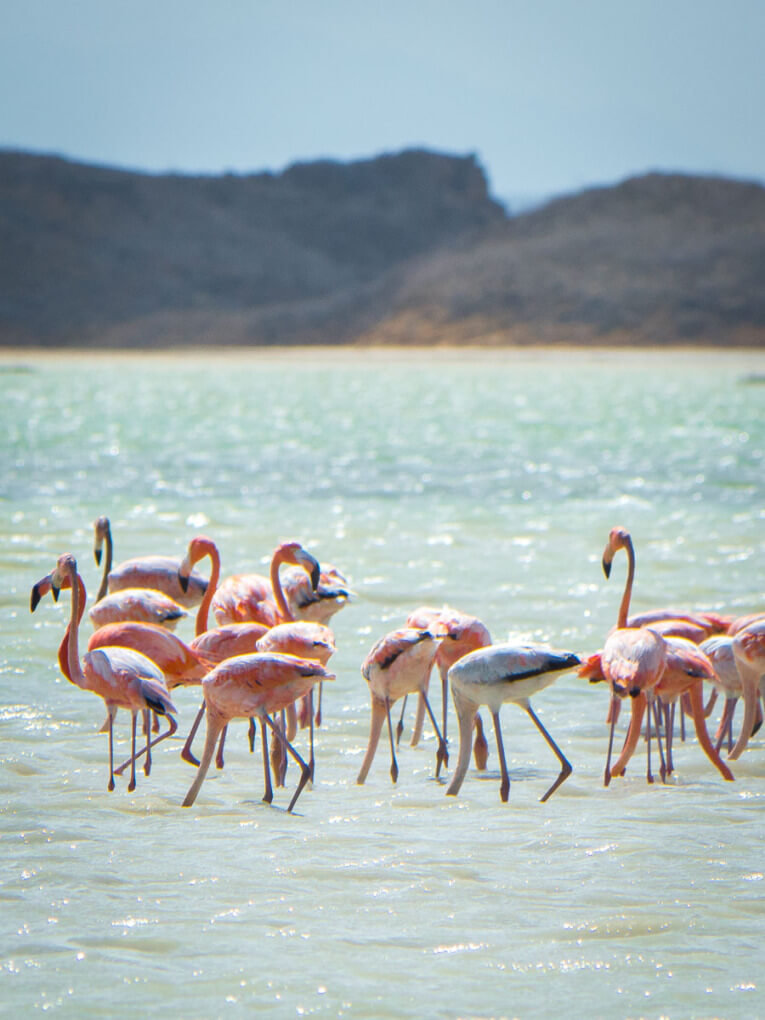
Responsible Local Agency
As you’ll have understood from our post, it’s essential to go into the desert with a serious agency. Paola’s agency is one of the few in Riohacha to have developed responsible tourism in the Guajira desert. You can go with your eyes closed and break the piggy bank to go as far as Macuira!
Departure from the Guajira desert
Tour from Cabo de la Vela to Punta Gallinas
We set off again into a fabulous Martian landscape that makes us want to fly the drone. Every day, the landscapes behind the smoked windows of the 4×4 are more surprising than the last.
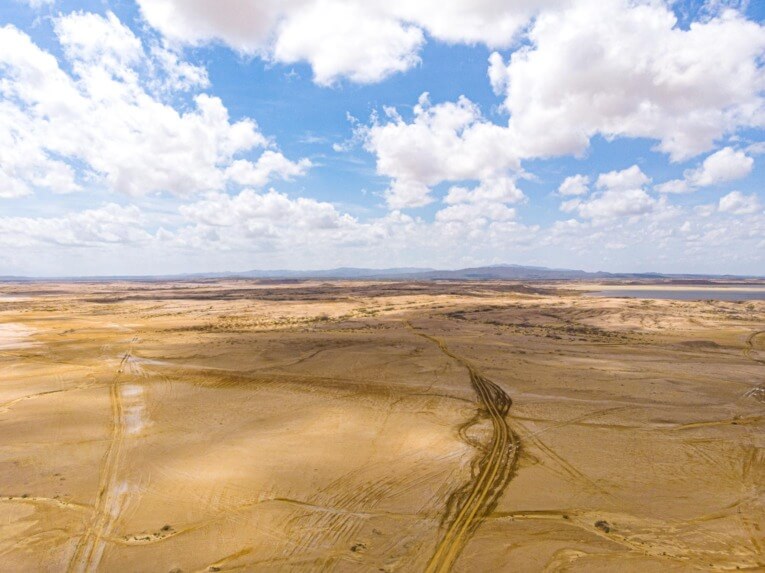
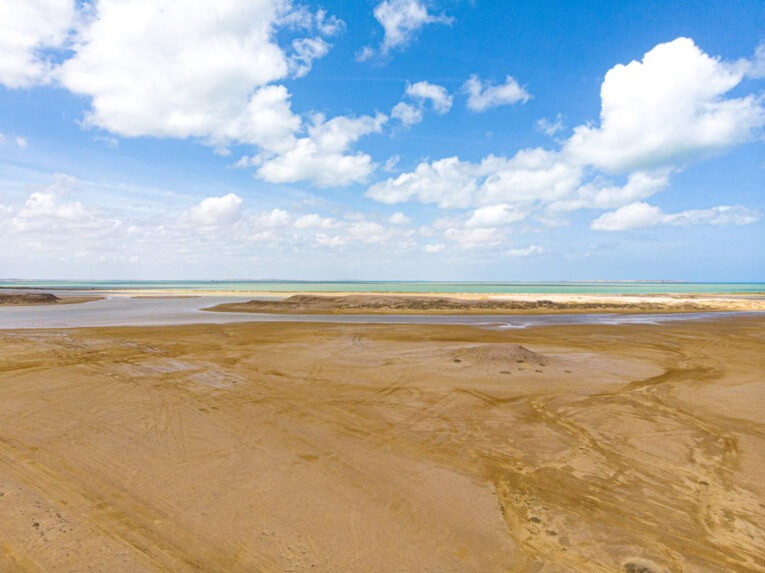
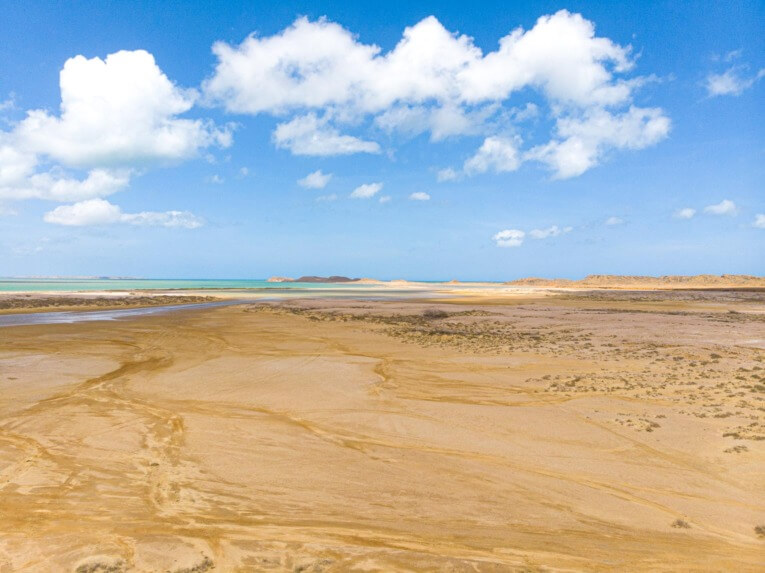
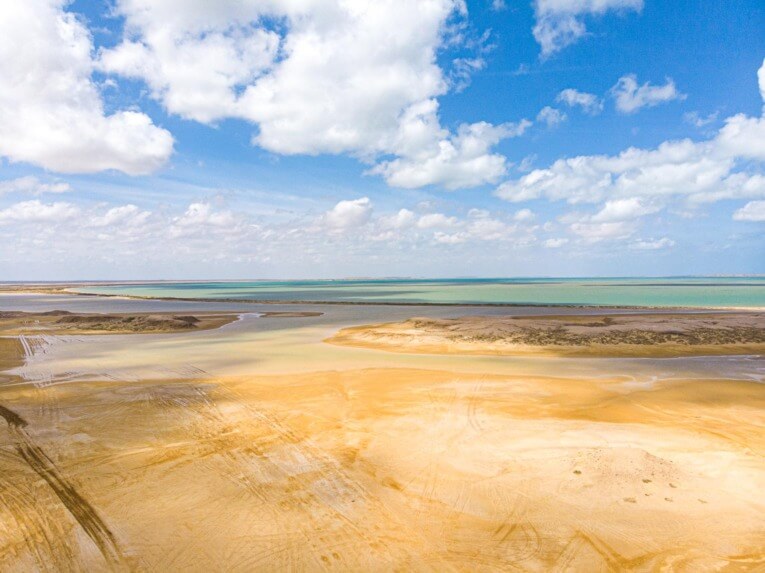
During these four days, we had the pleasure of admiring the changes in vegetation surviving on these arid lands according to their geographical location, closer or further from the sea, closer or further from a mountain..
The earth’s colors also vary, from ochre to almost white, through all shades of gold.
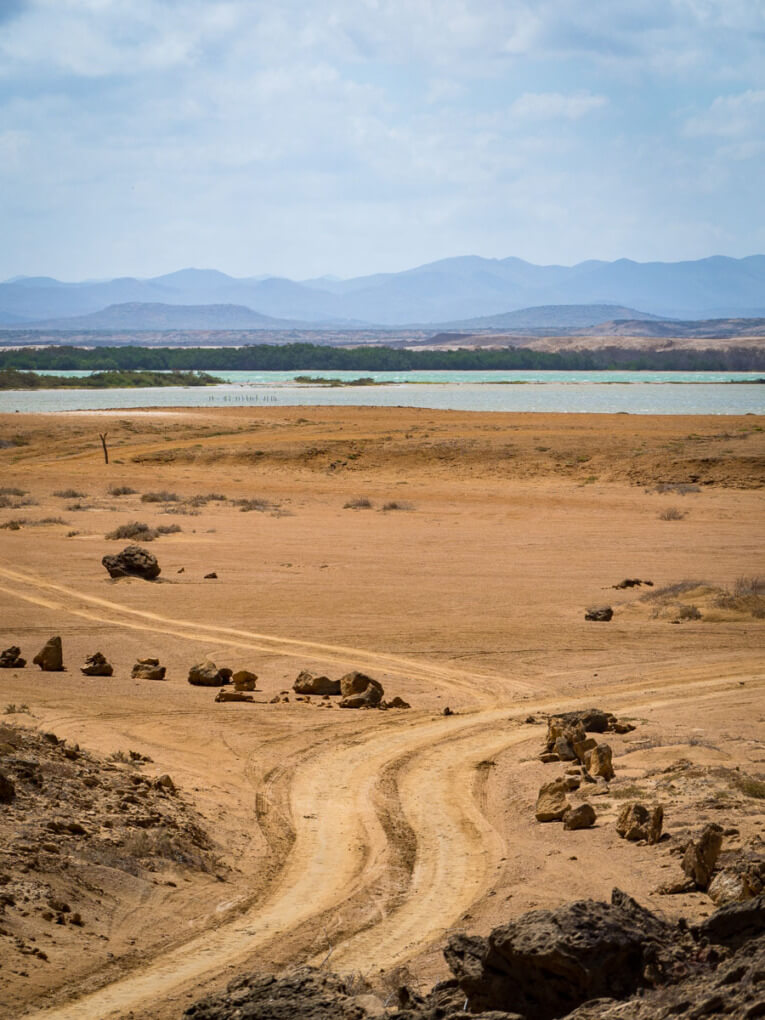
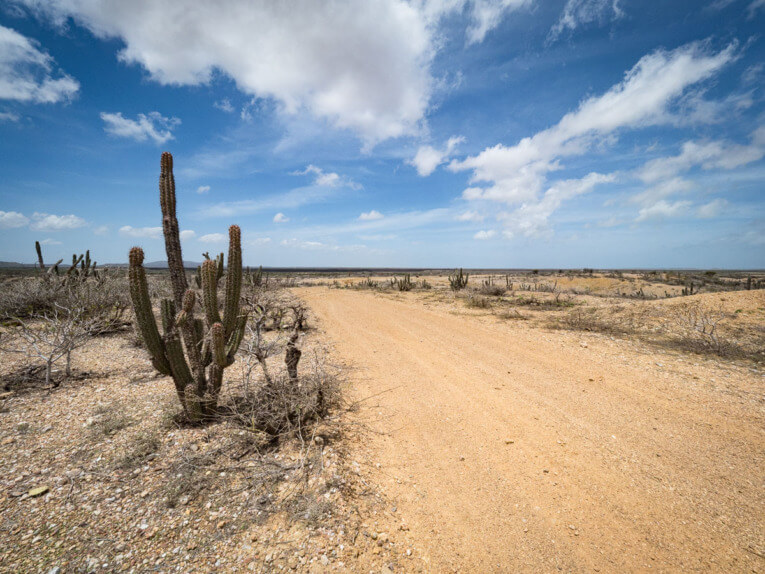
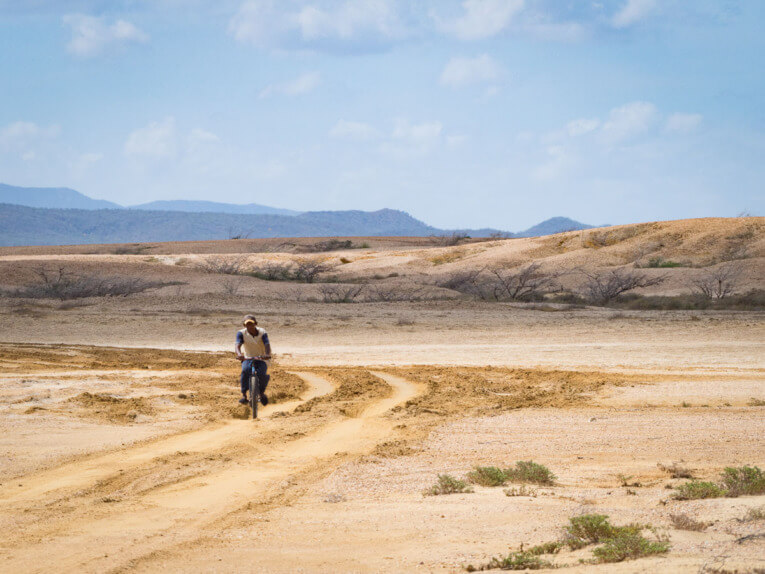
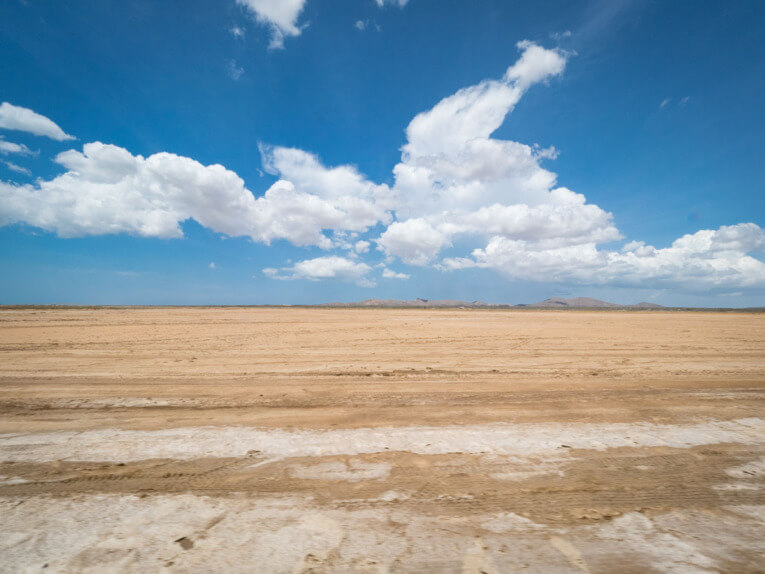
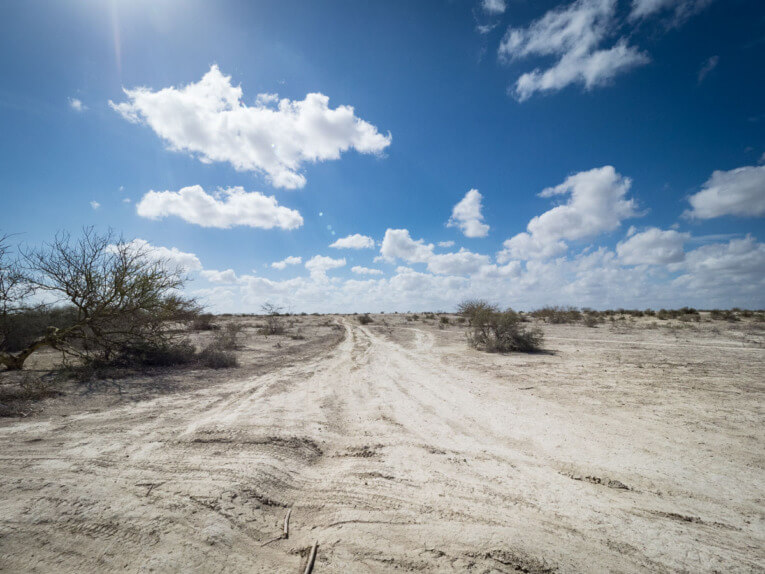
Everywhere, huge cactuses, like in a western movie, and everywhere the pollution of plastic bags carried by the winds, which end up clinging to anything that stands in their way: a cactus, a barbed-wire fence, a tree..
The return journey is long and tiring after 4 days. The kilometers roll by at the lurching pace of a battered 4×4 on chaotic tracks. Then comes Uribia and its smell of smuggled petrol.
Finally, the road gets rolling all the way to Riohacha.
THE END.
Contact Local Agency to do a Classic Tour of the Guajira Desert
If you want to go to Cabo de la vela and Punta Gallinas contact our local partner!
(No Macuira National Park group Tour is available. Only private tours go there and it’s really expensive unless you’re between 4 and 6 people.)
Contact agency to visit the GUajira desert in Colombia
Our advice to anyone wanting to do the classic desert tour, including Cabo de la Vela and Punta Gallinas, is to budget for the 4-day plan, which includes a meeting with a Wayuu family.
For us, it was choosing to push on to the Macuira National Park that totally saved our experience. But unfortunately no Macuira National Park group Tours are available. Only private tours go there and it’s really expensive unless you’re between 4 and 6 people because la Macuira is very far into the desert!
Where to stay in Riohacha
Riohacha

Appartement
Casa Origen
Double room : $100.000 to $150.000 COP
This is where we stayed during our 10 days in Riohacha. This perfectly located house, two blocks from the beach, offers several beautifully decorated rooms for rent with air conditioning. Tthe hosts, Jeanne and Julian, offer superb local experiences.
Riohacha

Hostal
Bona Vida
Dormitory : $25.000 to $50.000/Double room : $100.000 to $150.000 COP
A Riohacha success story, Bona Vida now has 4 or 5 (we don’t know) different locations in the city. Always in a colorful atmosphere and with the famous “pancake” breakfast for which it is famous.
How to get to the Guajira Desert in Colombia
To discover the Guajira desert, you first need to get to Riohacha. There are two ways of doing this: either by bus, or by plane from one of Colombia’s major cities. The nearest major city is Santa Marta.
Getting to Riohacha by bus
Riohacha bus terminal
- Address: Calle 16a #11-2 a 11-154
- Telephone: 57 (5) 727 2739
To/from the Bus Terminal
The Bus Terminal is about 10 minutes by cab and 20 minutes on foot from downtown Riohacha.
Bus from Santa Marta to Riohacha (2h30)
From the Bus Terminal or Mercado Publico, direction Riohacha.
- Fare: approx. $20.000 COP
- Companies: Copetran and many other small companies from the Mercado Publico
Bus from Cartagena to Riohacha (7h)
- Fare: approx. $40.000 COP
- Companies: Copetran, Unitransco, Expreso Brasilia
Getting to Riohacha by plane
To/from the airport
The airport is about 15 minutes by cab or 20 minutes by bus from downtown Riohacha
Flight from Bogota to Riohacha (1h40)
- Fare: approx. $160.000 COP
- Airlines : Avianca
Flight from Medellín to Santa Marta (1h15)
There are no direct flights from Medellín to Riohacha.
- Fare: approximately $150.000 COP
- Airlines : Avianca
